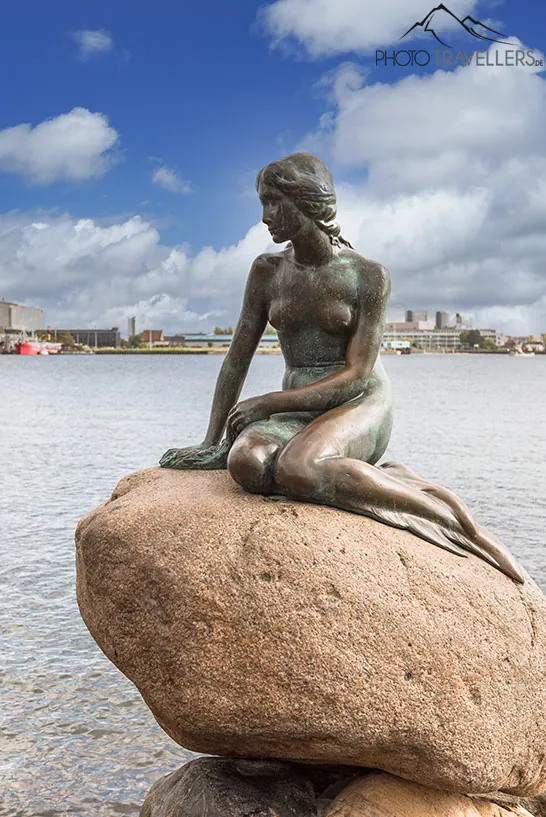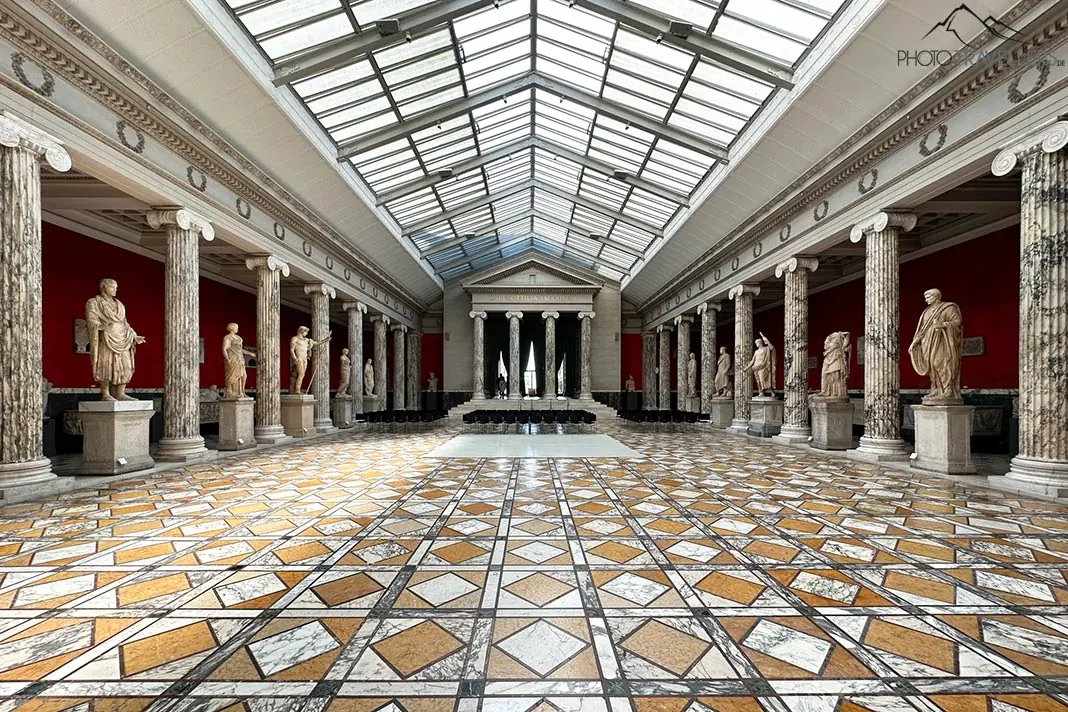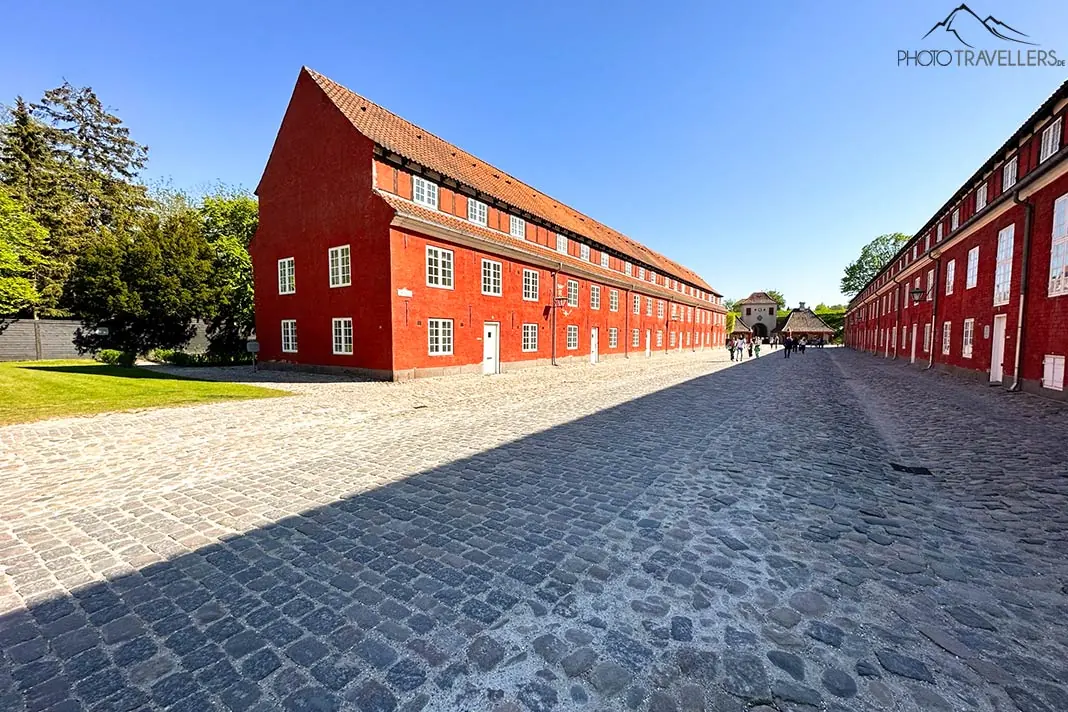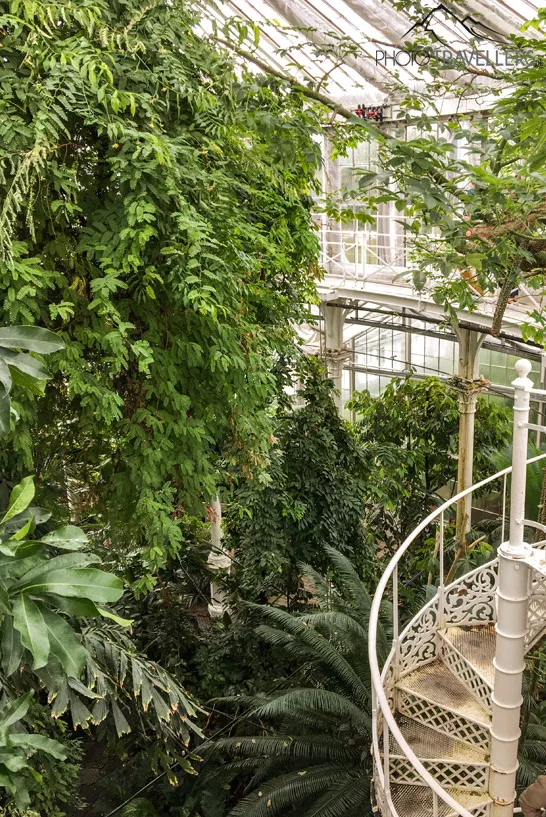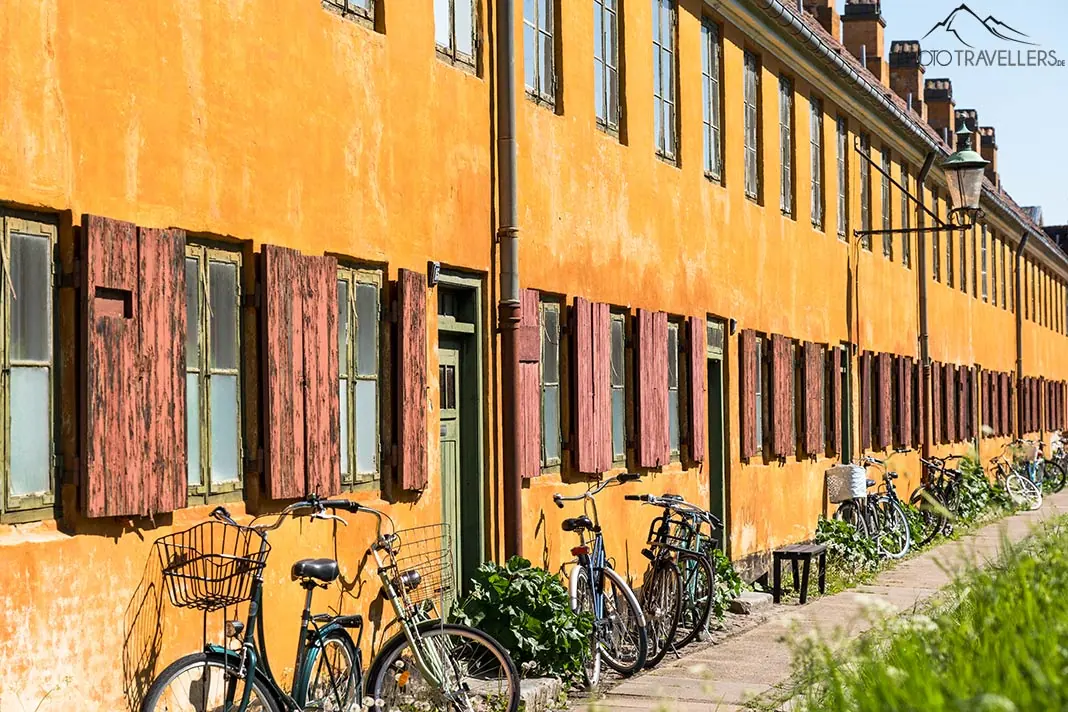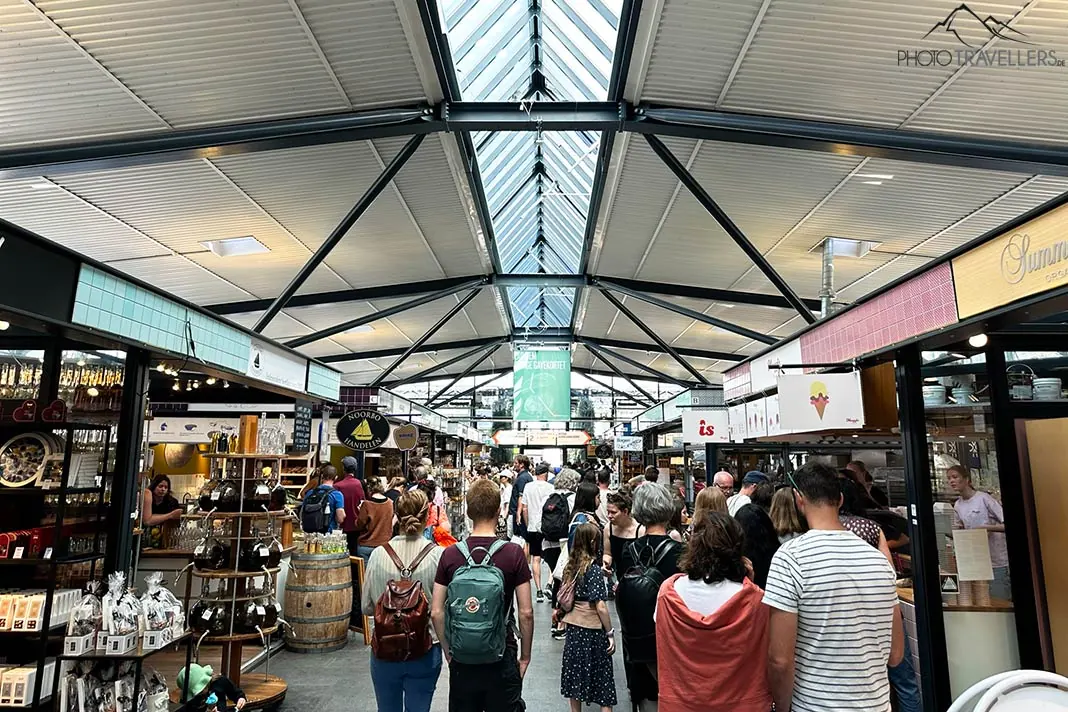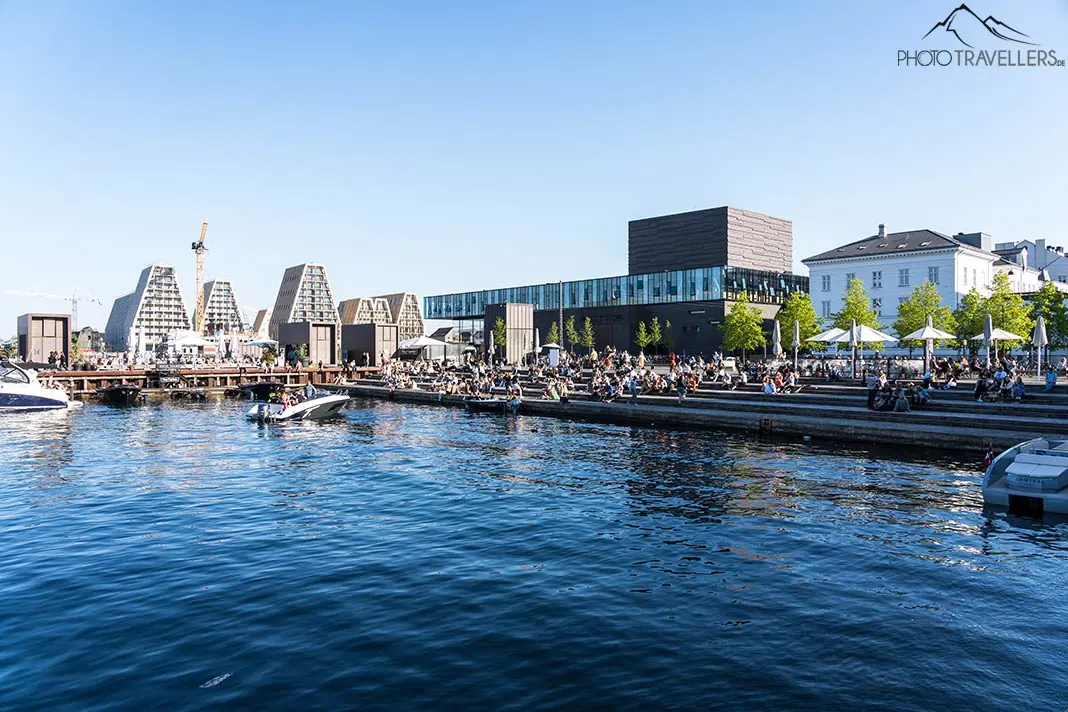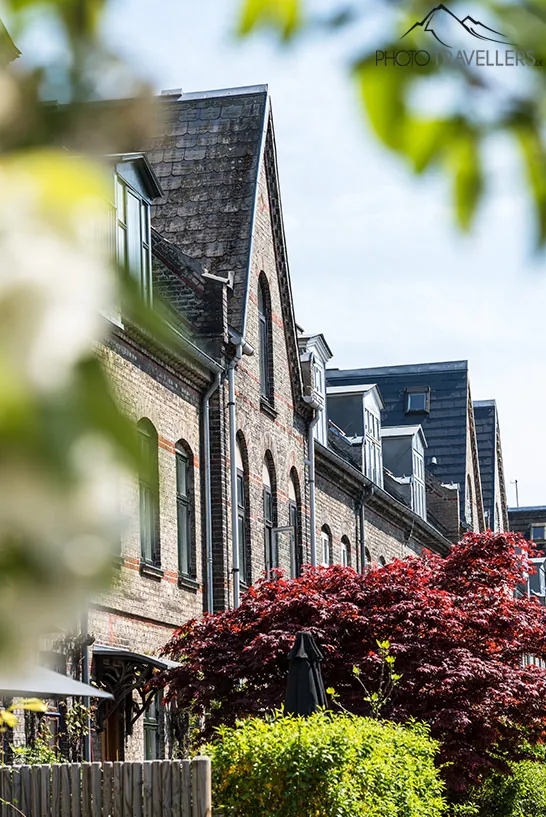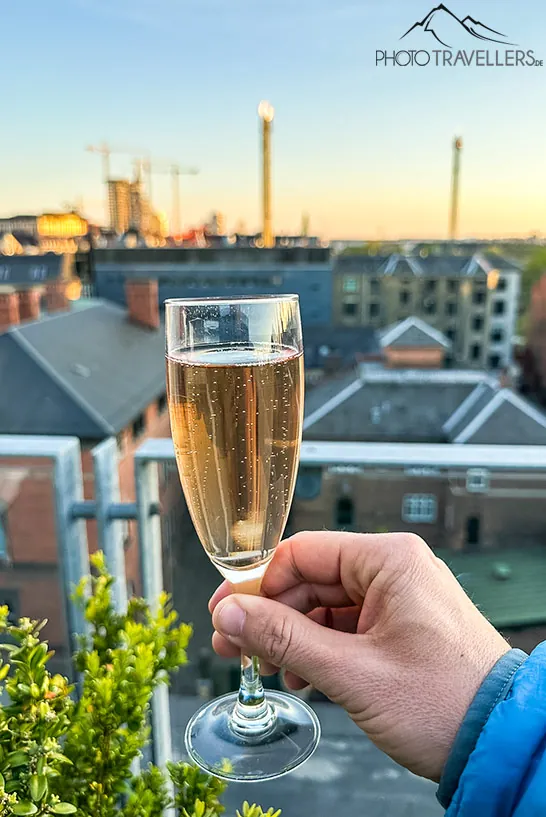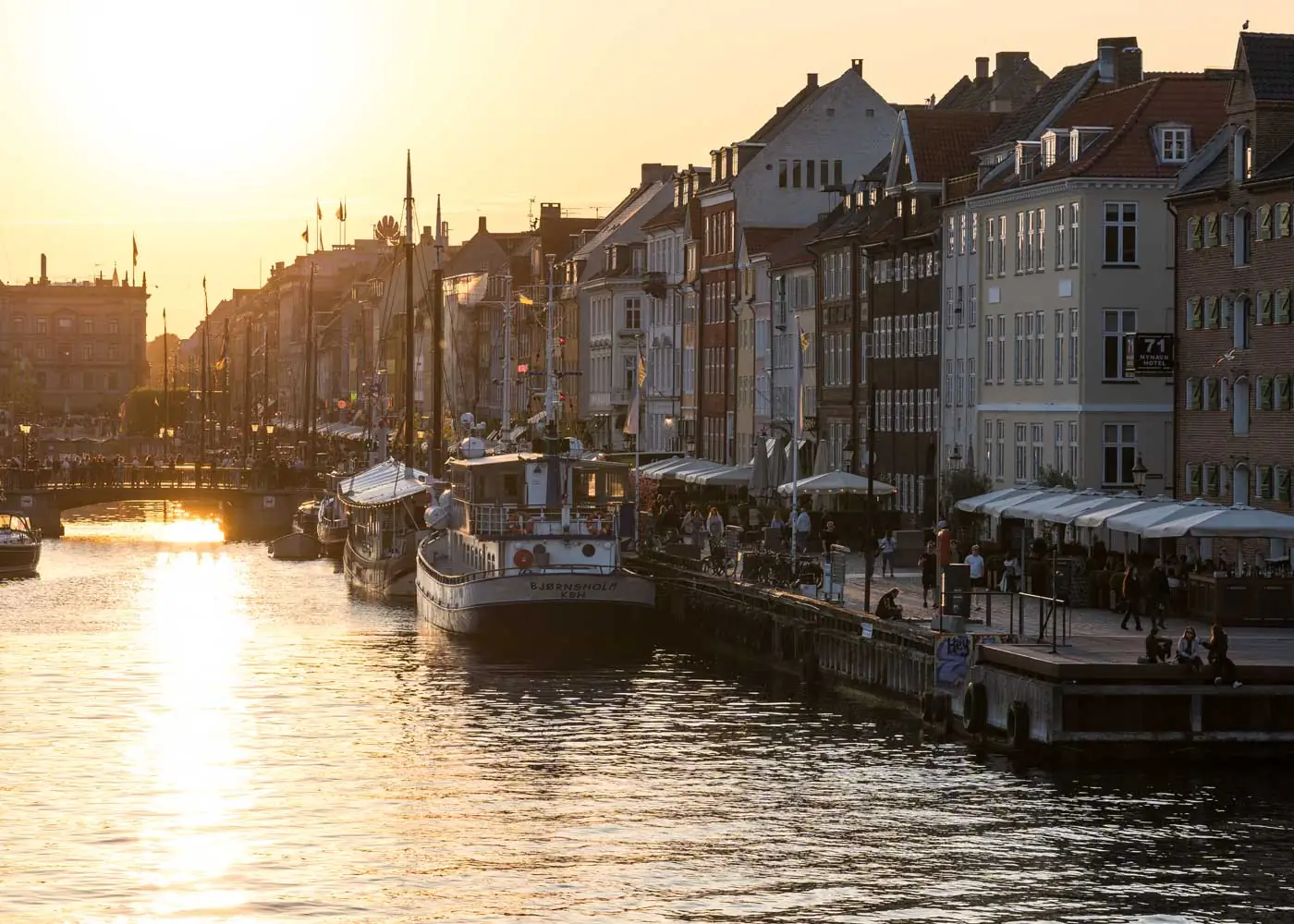
25 best things to do in Copenhagen for 2023
The Danish capital Copenhagen really enchanted us. The city inspires with beautiful places and exciting sights such as the Little Mermaid, Nyhavn and the imposing Rosenborg Castle.
But what else is there to see in Copenhagen? We take you on an unforgettable trip and show you the most important highlights and of course some insider tips in Copenhagen.

Hi! Wir sind Biggi & Flo
Wir nehmen dich als Reisejournalisten mit zu den schönsten Orten der Welt!
Werbehinweis: Alle mit einem * markierten Links sind Werbelinks.
At a glance: What to do in Copenhagen
Little Mermaid: One of the smallest landmarks in the world
Nyhavn: The New Harbor is the “place to be” in Copenhagen
Rosenborg Castle: One of the most impressive castles in the country, right in the city center
Tivoli: What would Copenhagen be without the world-famous amusement park?
That was just a small taste of what awaits you in Copenhagen. You can easily explore the city and most of the famous attractions on foot. We recommend planning three to four days for Copenhagen. At the end of the article you will find our interactive map with an overview of all Copenhagen sights.
1. Little Mermaid
We start with what is probably Copenhagen’s most famous sight. The Little Mermaid is a statue by Danish sculptor Edvard Eriksen, who modeled it on the fairy tale of the same name by Danish poet Hans Christian Andersen.
The bronze figure is just over one meter high, making it one of the smallest landmarks in the world. The Little Mermaid has been located on the Langelinie waterfront promenade since 1913. However, this is only a copy. The original is kept by the sculptor’s family in an unknown location.
The Little Mermaid enjoys great popularity. Everyone wants to take a picture with the mermaid. You can expect a very large crowd, especially in summer.
Tip: Nearby is St. Alban’s Church with the Gefion fountain, which is “guarded” by a majestic bronze figure of four bulls. A detour is worthwhile.
2. Nyhavn – the New Harbor
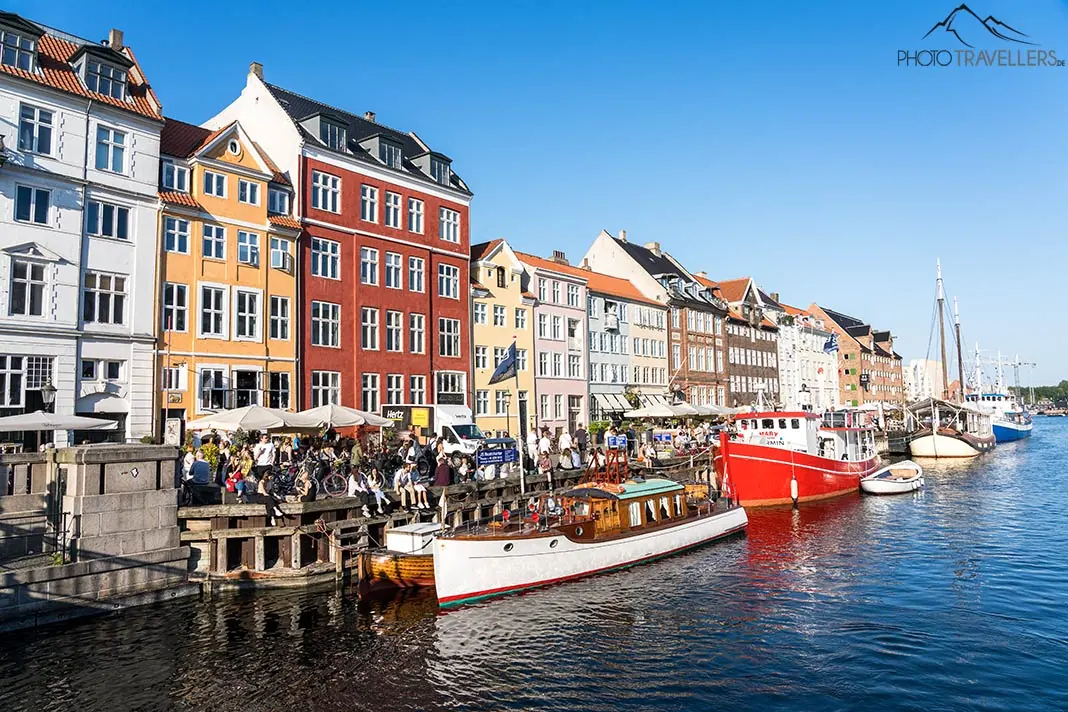 The New Harbor is one of the most famous places in the city
The New Harbor is one of the most famous places in the city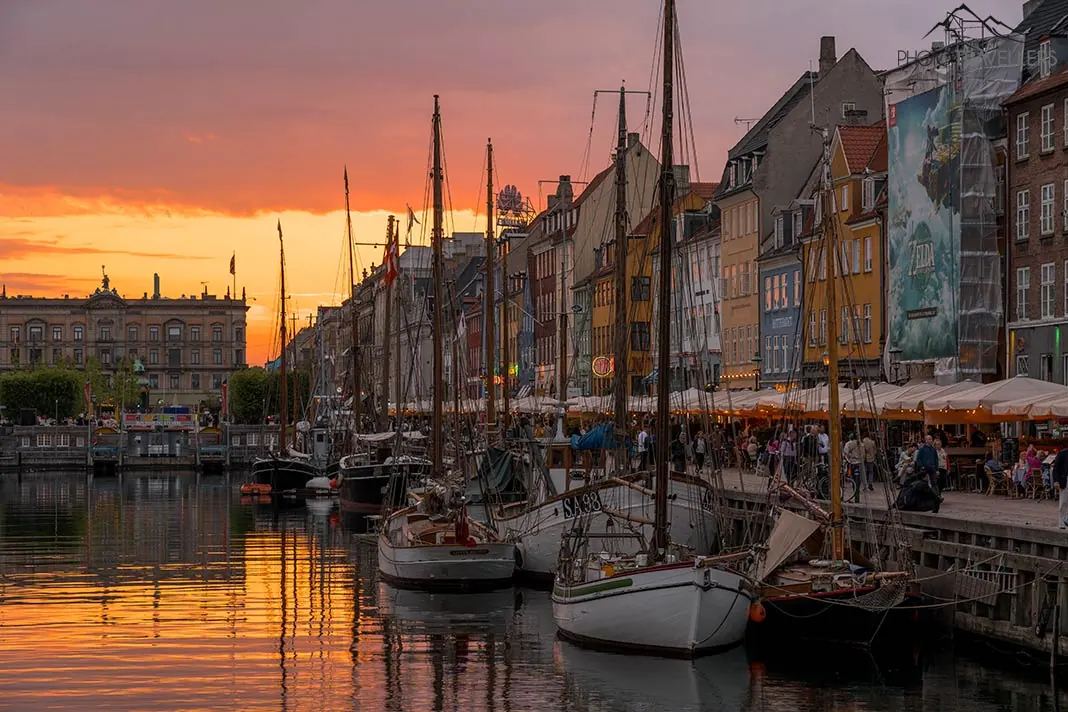 We had a fantastic sunset here
We had a fantastic sunset hereThe city’s most famous postcard motif is certainly the New Harbor, which is called Nyhavn in Danish. The New Harbor is a 17th century canal and was a central trading port of the Danish capital until the 20th century. Incidentally, even the famous poet Hans Christian Andersen lived in different buildings here at different times – in the houses with the numbers 18, 20 and 67.
Nyhavn has become one of the most photographed places in Copenhagen thanks to the colorful gabled houses on both sides of the canal, most of which are from the 18. and 19th century. There used to be numerous pubs here. Today, the area is a popular entertainment and nightlife district with many bars and restaurants.
Here in Nyhavn, you can also set off on a canal cruise*.
Tip: The New Harbor is of course not an insider tip, but a real tourist hotspot. If the hustle and bustle gets too much for you, walk across the Inderhavnsbroen pedestrian bridge (the inner harbor bridge), which connects Nyhavn with the Christianshavn district to the east. From spring to the end of October there is the huge Broens Gadekøkken food market with snacks, bars and seating near the water. In winter, you can skate on an ice rink. Ingenious, isn’t it?
3. Rosenborg Castle
 For us, Rosenborg Castle is the most beautiful castle in the city
For us, Rosenborg Castle is the most beautiful castle in the city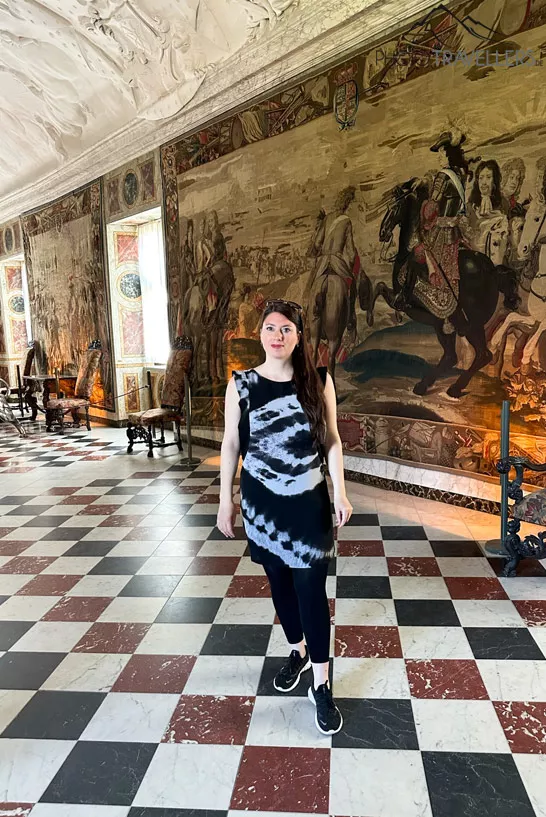 This is the imposing Knights’ Hall
This is the imposing Knights’ Hall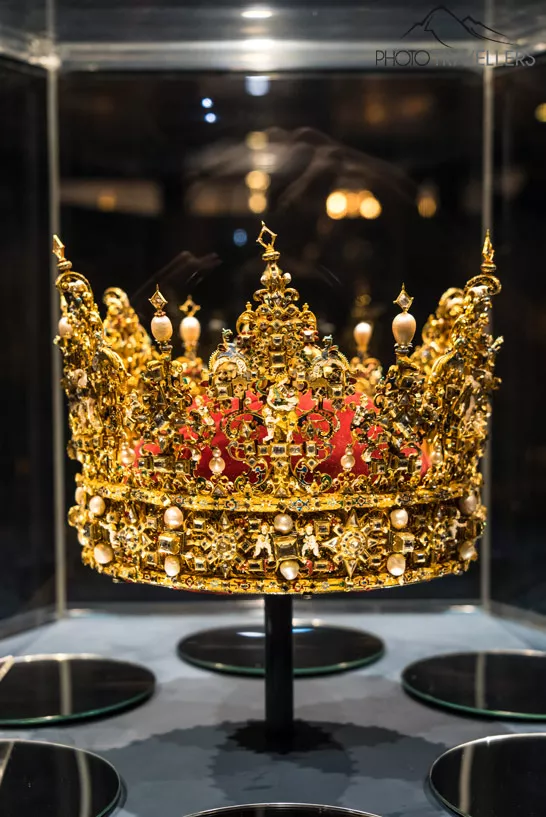 The Danish crown jewels are located in the castle’s cellar
The Danish crown jewels are located in the castle’s cellarLet’s move on to Rosenborg Castle (Rosenborg Slot), for us personally the most beautiful of the three castles in Copenhagen. Even from the outside, the 17th century castle is a feast for the eyes. It is also exciting to watch the heavily armed palace guards changing the guard.
You should definitely also visit the castle (tickets with a fixed admission time)! We really have seen the inside of many castles and palaces. Rosenborg Palace is definitely one of the most impressive with its magnificent rooms, such as the magnificent Knights’ Hall. The knights’ hall contains the anointing throne of the kings and the queen’s throne with the three silver lions. After the tour, you can take a look at the magnificent Danish crown jewels in the basement.
The adjacent Kongens Have park is also well worth a visit. The royal garden was once a pleasure garden and orchard.
Saving tip 1: On the opposite side of the King’s Garden you will find David’s Samling, the David collection. The museum houses a huge collection of paintings by Islamic, European and Danish artists and fine art from the early modern period. Admission is free.
Saving tip 2: We bought the Copenhagen City Card Discover* for our trip, which gave us free access to around 80 attractions in the city – including Rosenborg Palace and Tivoli, our next attraction. The Copenhagen City Card is also valid as a ticket for local public transport.
4. Tivoli
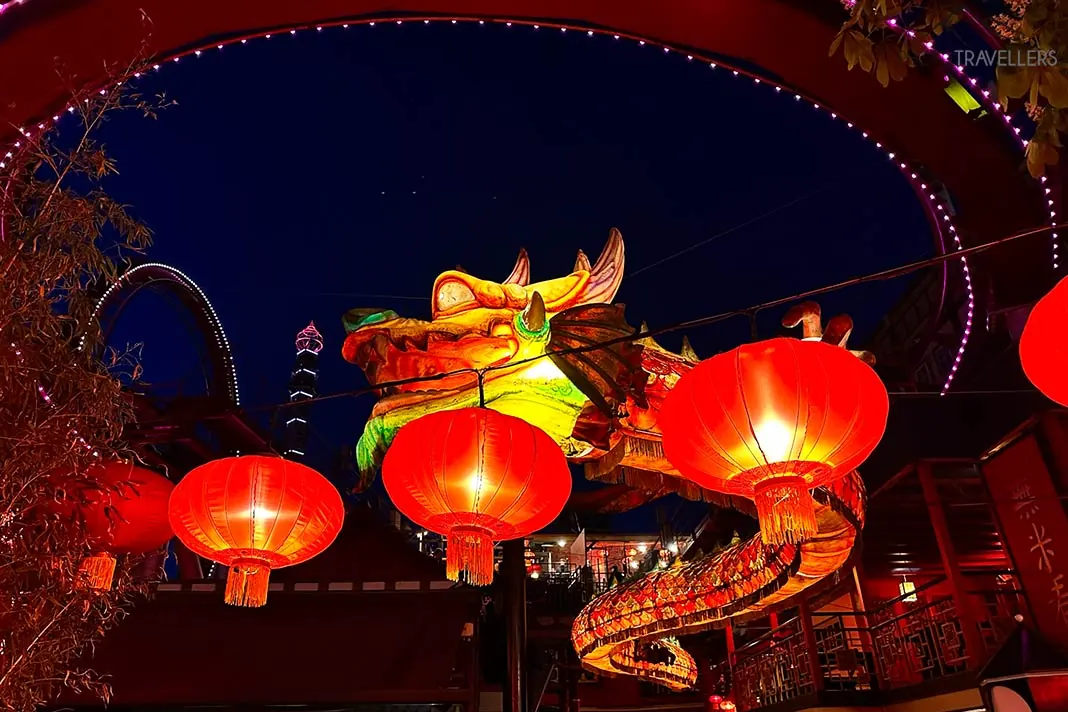 The Tivoli grounds are particularly beautiful to look at in the evening
The Tivoli grounds are particularly beautiful to look at in the evening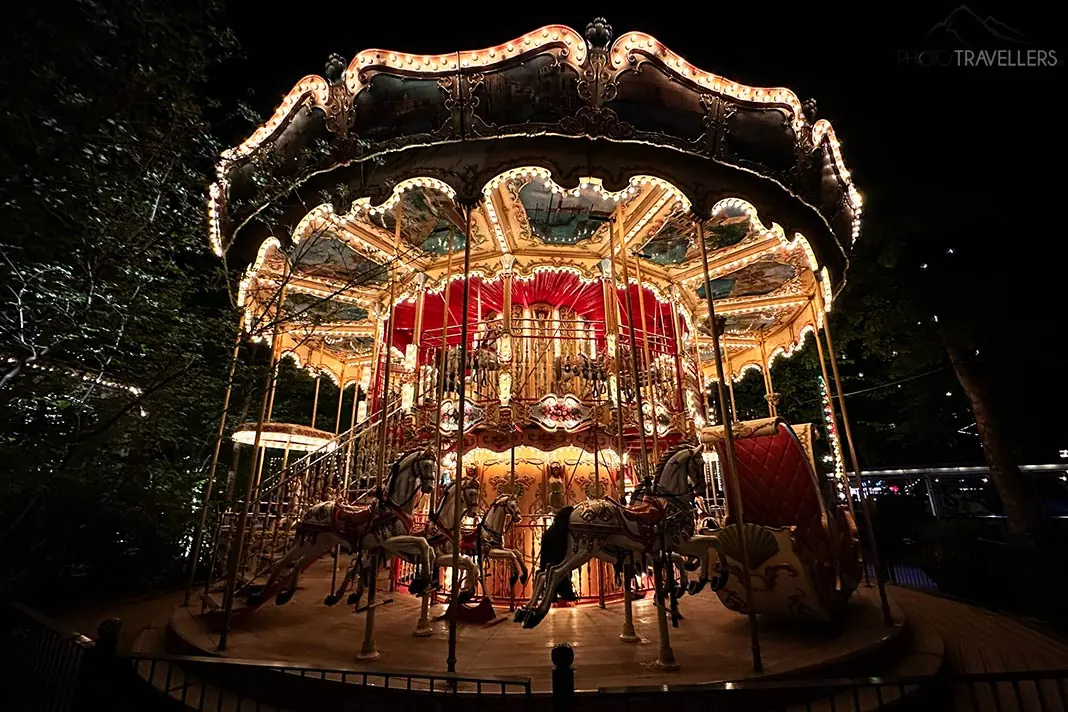 In addition to historic carousels, there are of course also fast-paced rides
In addition to historic carousels, there are of course also fast-paced ridesOne of the Copenhagen highlights that you absolutely must not miss is the Tivoli. Opened in 1843, Tivoli is one of the oldest amusement parks in the world.
Today, concerts are also held in the park, which is home to countless rides. The most famous rides include the wooden roller coaster from 1914, the Himmelskibet (the world’s largest chain carousel) and the Golden Tower (a 63-meter-high freefall tower), which are also a major feature of the Danish capital’s skyline.
We found the amusement park particularly beautiful at night when the rides light up. There is also a great laser show with background music on the lake in the park. Absolutely worth seeing!
The Tivoli is always open from mid-April to the end of September. There is also a Christmas market and a Halloween festival lasting several weeks in October.
The oldest amusement park in the world can also be found near Copenhagen, on the northern outskirts of the city. The Dyrehavsbakken – or Bakken for short – was opened back in 1583.
Tip: You can buy your ticket* for the Tivoli online here – so you don’t have to queue at the ticket office. Unfortunately, the ticket is only valid for access to the site. The rides cost extra. So a visit to Tivoli can add up to quite a tidy sum at the end of the day. Incidentally, Tivoli is also included in the Copenhagen City Card Discover*.
5. Rundetårn – the round tower
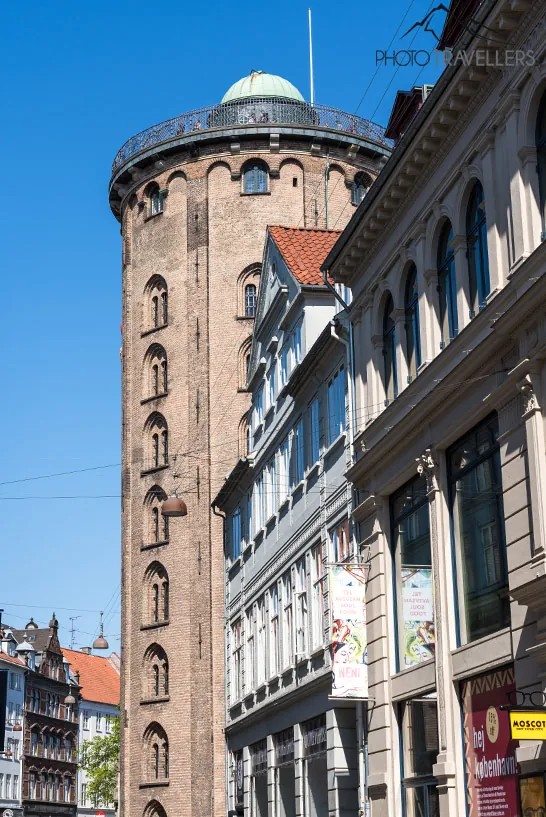 A visit to the Round Tower should not be missed on any trip to Copenhagen
A visit to the Round Tower should not be missed on any trip to Copenhagen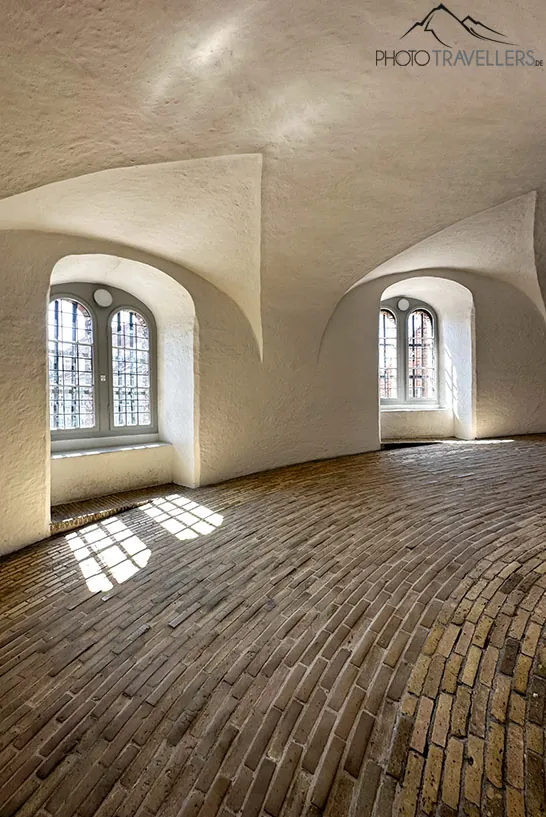 This is the wide corridor that leads upwards
This is the wide corridor that leads upwards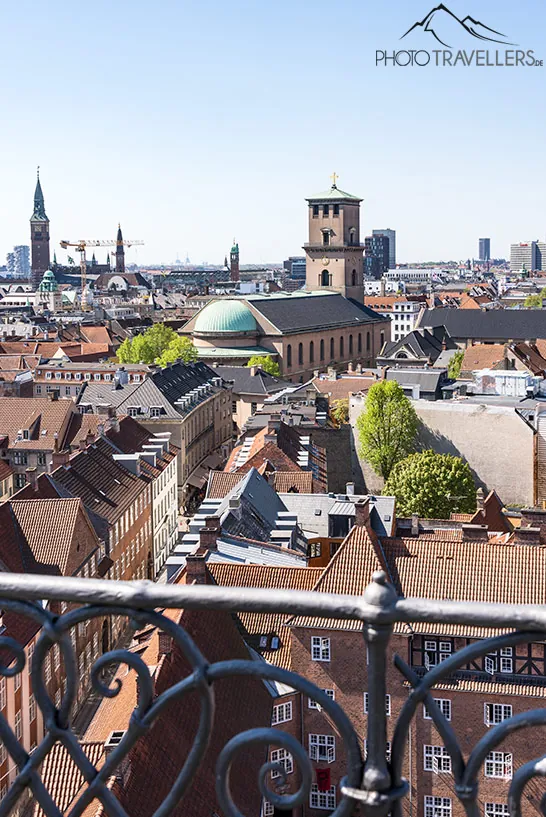 This is the view from the roof. By the way, here you can see the Frauenkirche, our top sight number 20
This is the view from the roof. By the way, here you can see the Frauenkirche, our top sight number 20The Rundetårn (Round Tower) is also a must-see on any trip to Copenhagen. The publicly accessible observatory is located in the middle of the historic old town. Even the ascent is exciting. Behind the entrance, a wide corridor spirals 209 meters (meaning the length, not the height) upwards. Why is that? Well, in the past, heavy instruments and books were transported to the top of the observatory by horse-drawn carriage – and this required space.
On the way up, you will pass an inconspicuous alcove. If there aren’t people standing here, you can easily miss them – so keep an eye out! Den Hule Kerne (the “hollow core”) is a shaft that stretches from the ground to the top of the tower. If you dare, you can step onto the glass floor and look down into the depths. Incidentally, it is still not known what the shaft was originally designed for.
The last section to the viewing platform on the roof is up a flight of stairs. The roof of the Round Tower is not only a special highlight for stargazing – you also have a fantastic panoramic view from here during the day. It is also home to the oldest functioning observatory in Europe, which makes the tower an Outstanding Astronomical Heritage Site.
6. Christiansborg Castle
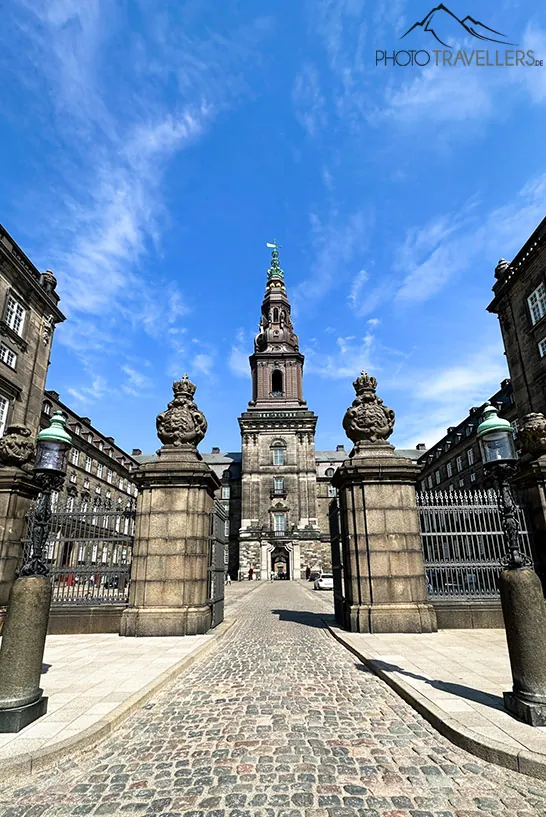 Incidentally, you can climb the tower of Christiansborg Palace free of charge
Incidentally, you can climb the tower of Christiansborg Palace free of charge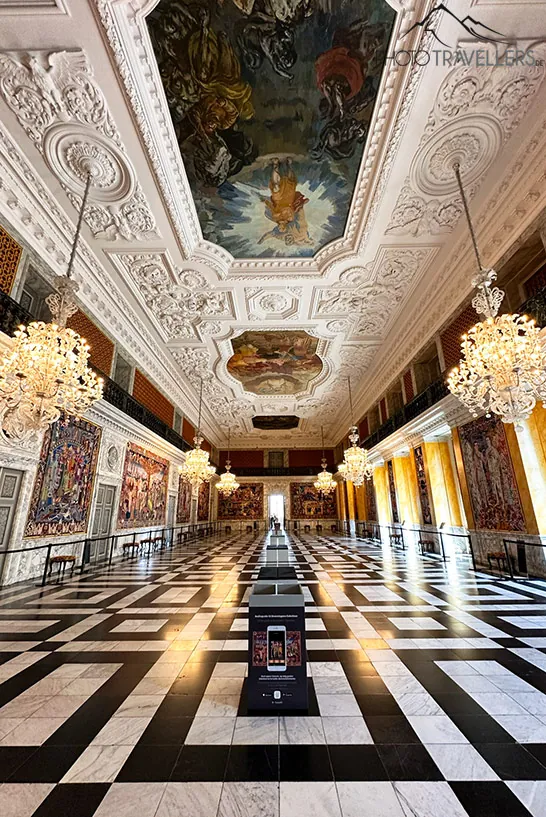 But the ticket for the interior is well worth it
But the ticket for the interior is well worth it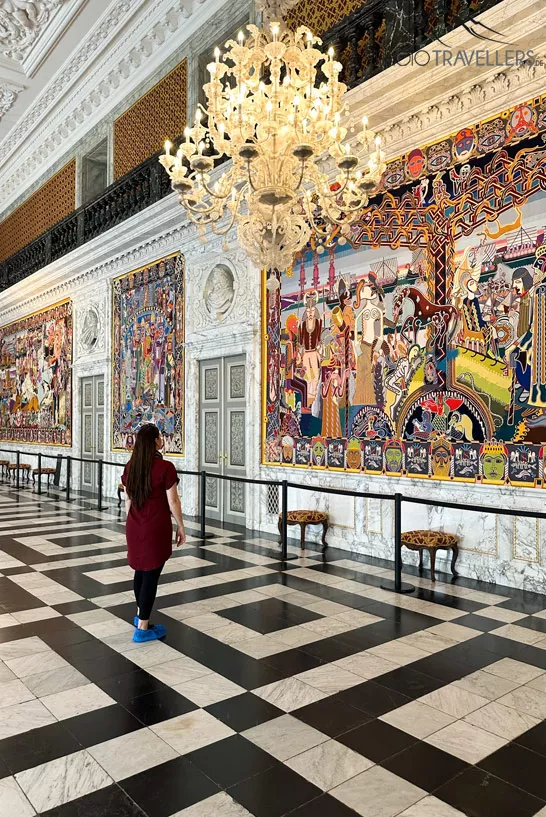 We were really impressed by the castle! The blue plastic covers over the shoes are mandatory to protect the floors
We were really impressed by the castle! The blue plastic covers over the shoes are mandatory to protect the floorsAnother highlight is Christiansborg Palace. In addition to the Danish Parliament, the magnificent building also houses the Supreme Court and an official residence of the Prime Minister. The palace is also used by the royal family for official occasions.
This makes it the only representative building in the world to unite the highest representatives of the executive, legislative and judicial branches under one roof.
It’s worth climbing the striking tower, from where you have a breathtaking panoramic view (admission free). At 106 meters, the tower of Christiansborg Palace is the tallest in the city. The castle church is also freely accessible.
You have to buy a ticket for the royal reception rooms, the library and the famous castle kitchen. The same applies to the stables with the royal horses and the carriages on display.
7. Vor Frelsers Kirke – the most beautiful view over the city
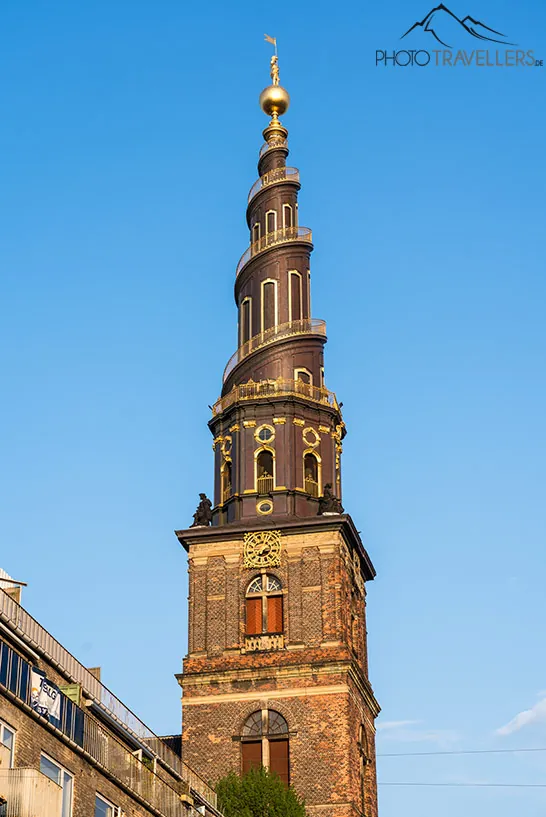 The top of the Church of the Redeemer not only looks exciting, you can even climb up here
The top of the Church of the Redeemer not only looks exciting, you can even climb up here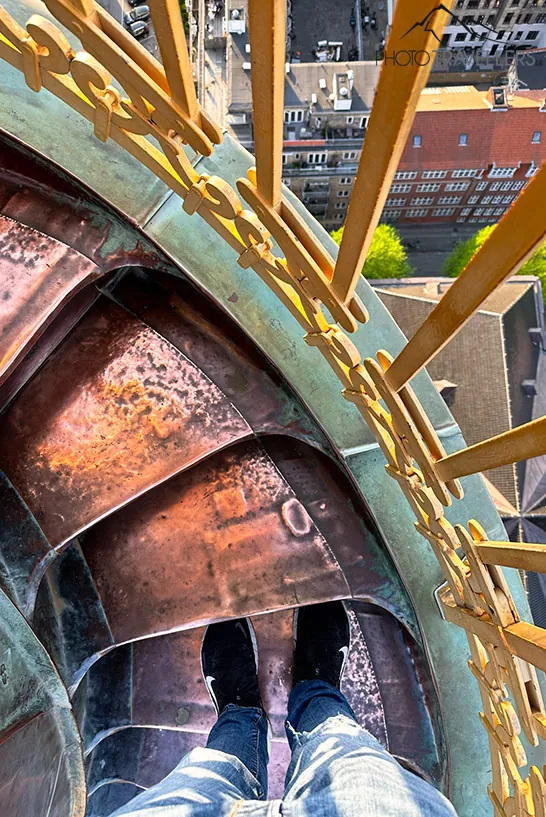 The staircase on the outside of the tower becomes narrower and narrower towards the top
The staircase on the outside of the tower becomes narrower and narrower towards the top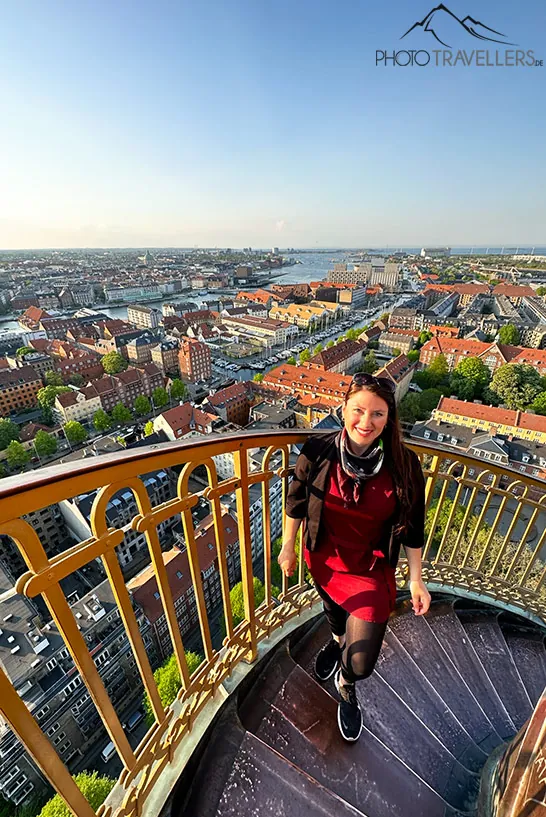 You have this great view from the tower
You have this great view from the towerHave you ever climbed up the outside of a church tower? At Vor Frelsers Kirke, the Church of the Redeemer, you can do just that. We have never seen anything like it anywhere else in the world, let alone done it.
From the tower, which is reminiscent of a corkscrew, you have a fantastic view over Copenhagen. We would even say that you have the best view of the city from up here.
Incidentally, it takes a bit of courage to climb the stairs, which get narrower and narrower as you go up. We have seen some visitors who had serious problems with this. But if you dare, an unforgettable experience awaits you.
Tip: Visit the tower about half an hour before closing time. Then you have the perfect light for taking photos. You should definitely get your ticket online in advance!
8. Amalienborg Palace
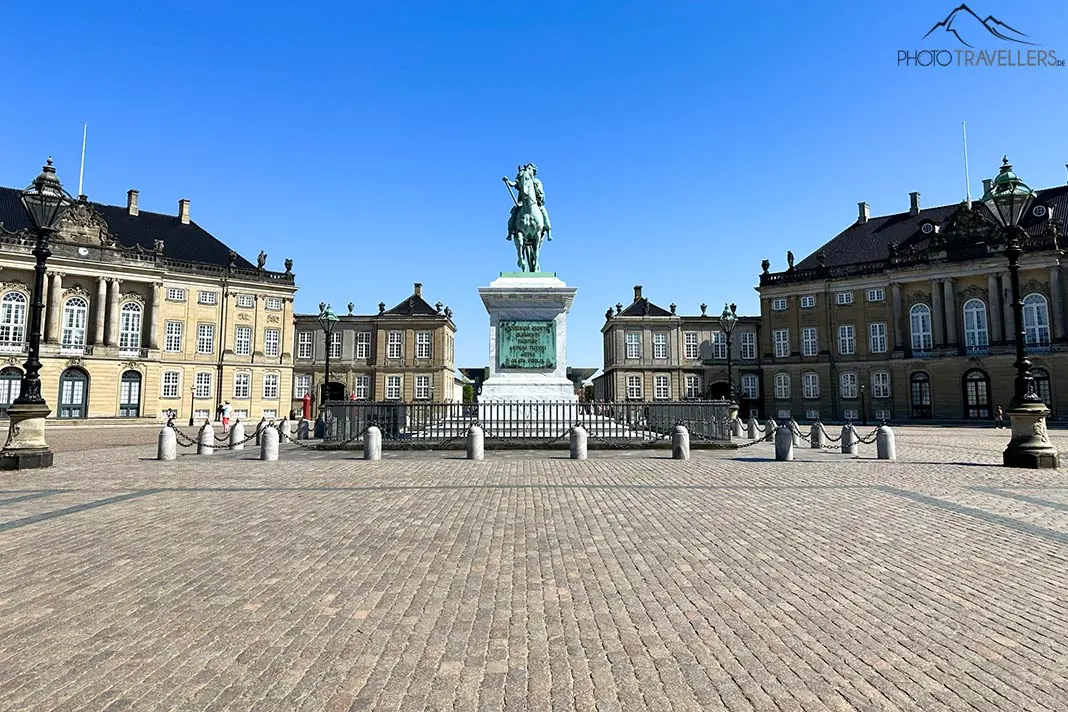 A statue of Frederik V stands in the middle of the castle square.
A statue of Frederik V stands in the middle of the castle square.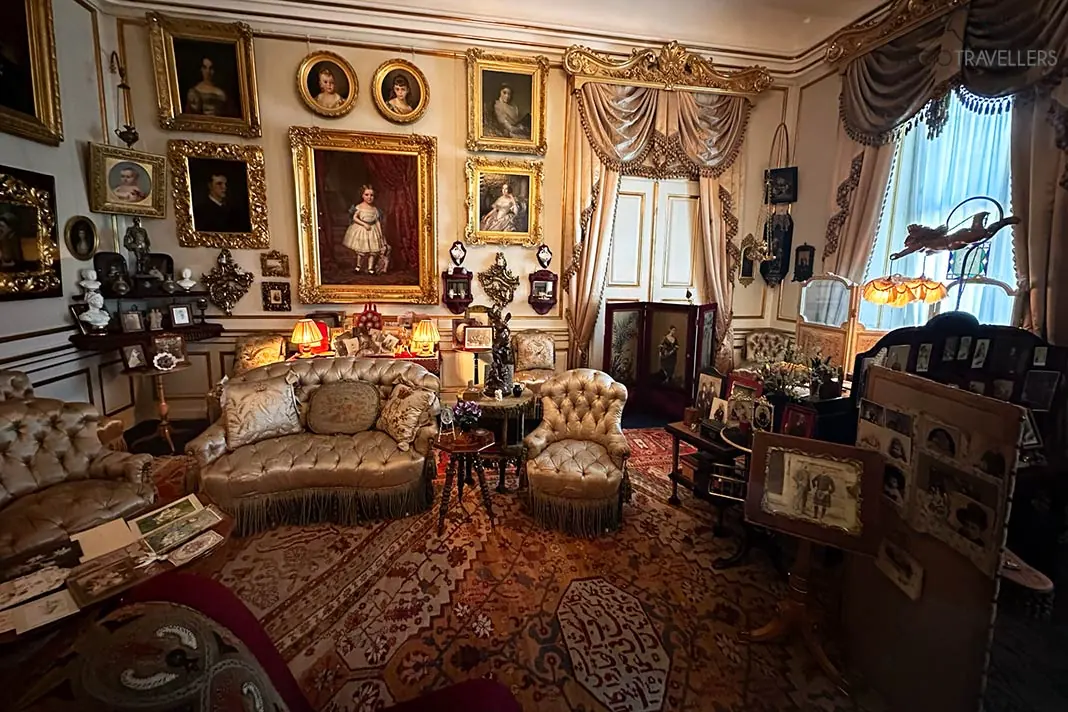 The Copenhagen city residence of the Danish queen also impresses from the inside
The Copenhagen city residence of the Danish queen also impresses from the insideAmalienborg Palace is the city residence of Queen Margrethe II of Denmark. The castle is located in the immediate vicinity of Frederik’s Church (more on this in a moment). An absolute highlight: when the royal family is on site, the changing of the guard takes place in front of the palace every day at 12 noon. If no member of the family is present, a smaller palace guard takes place instead of the large royal guard.
The complex consists of a palace square with an equestrian statue of Frederick V, four almost identical palaces and small French-style gardens. You can visit two of the palaces – a museum in the Palais Levetzau and the Palais Moltke, if the royal family is not there.
Tip: Café Mormors (Google Maps) is located near Amalienborg Palace. The cute café is not only furnished in a super nostalgic style, but has also been visited by royalty.
9. Ny Carlsberg Glyptotek
This sight is also a must-see on any trip to Copenhagen: the Ny Carlsberg Glyptotek. The art museum in the south of the city center mainly houses sculptures, for example by Edgar Degas. The museum also boasts an exciting architectural mix including a conservatory and glass dome.
The name comes from the Carlsberg brewery, as the family’s art collection forms the basis of the museum. Even today, the museum is partly financed by a surcharge that is added to each bottle of beer of the brand.
Incidentally, a glyptotheque is a collection of sculptures – but you can also marvel at great paintings in the museum.
10. Kastellet
The Kastellet is also worth a visit. The fort dates back to the 17th century and was once part of the town fortifications. The well-preserved complex was designed in the shape of an almost perfect pentagon, with a bastion at each corner. This is how the special star shape comes about.
Today you can visit a commander’s house, a church and even a windmill in the Kastellet. The green area is particularly popular for walking and thanks to its excellent views. The remains of the fortress are freely accessible and open daily from 6 a.m. until sunset.
Tip: The delicatessen Løgismose Vin, Mad & Delikatesser is located directly at Kastellet (Google Maps). Here you will not only find tasty treats, but also excellent wine.
11. Free city Christiania
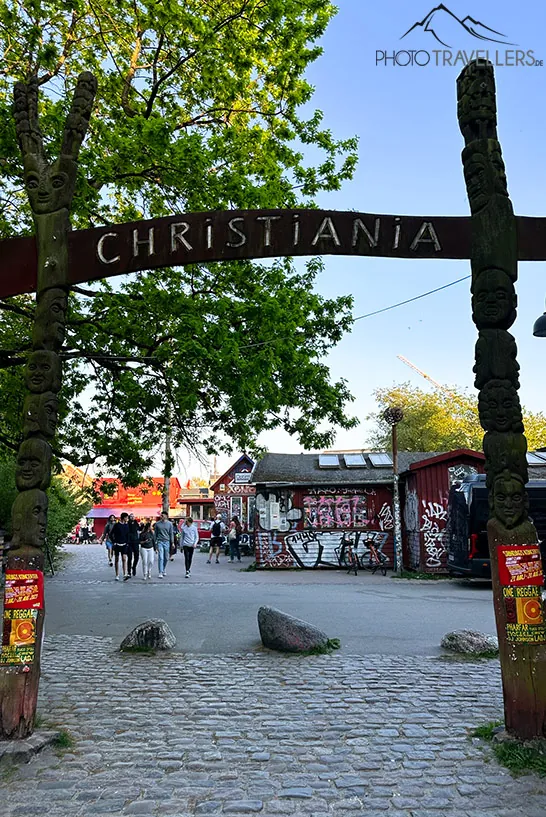 Welcome to the Free City of Christiania
Welcome to the Free City of Christiania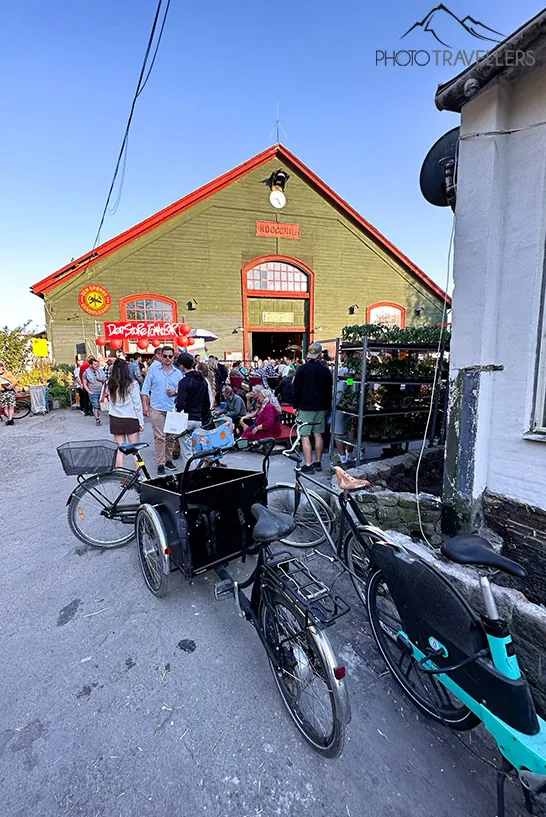 There are several cafés and bars in Christiania
There are several cafés and bars in Christiania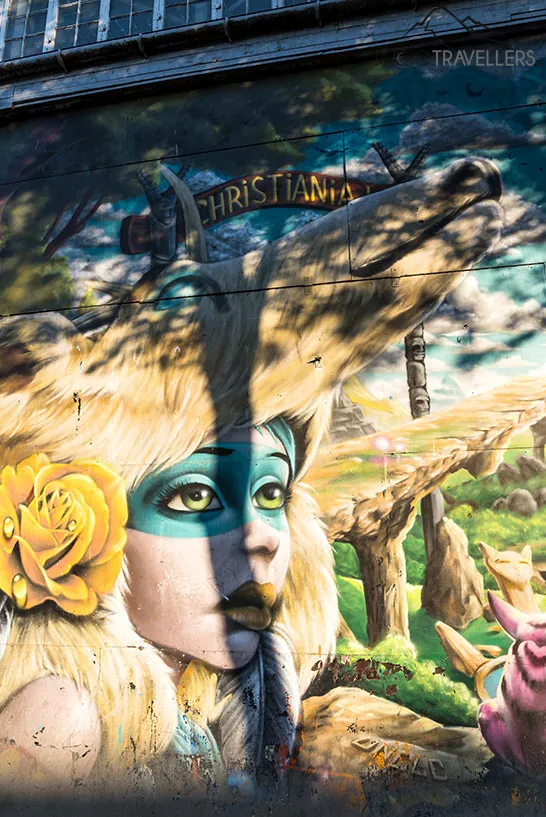 But art is not neglected in Freistadt either
But art is not neglected in Freistadt eitherThe self-proclaimed Free City of Christiania is an alternative housing estate or autonomous municipality tolerated by the state and is now one of Copenhagen’s best-known tourist attractions. A community often referred to as hippies has lived on the former barracks site since 1971. For example, cars and motorcycles are prohibited.
However, the “drug alley”, Pusher Street, is also notorious for the local drug scene with sales stalls and gang violence. There are numerous signs there informing you that photography is prohibited. You should definitely stick to this.
You are generally allowed to take photos in the rest of the area – with consideration for people, of course. Always pay attention to the signs and respect the rules of the settlement.
In Christiania itself there are several stores, bars, restaurants and lots of street art. However, we personally didn’t like Christiania that much. But perhaps we simply had the wrong and overly romantic ideas?
12. City Hall and Rådhuspladsen
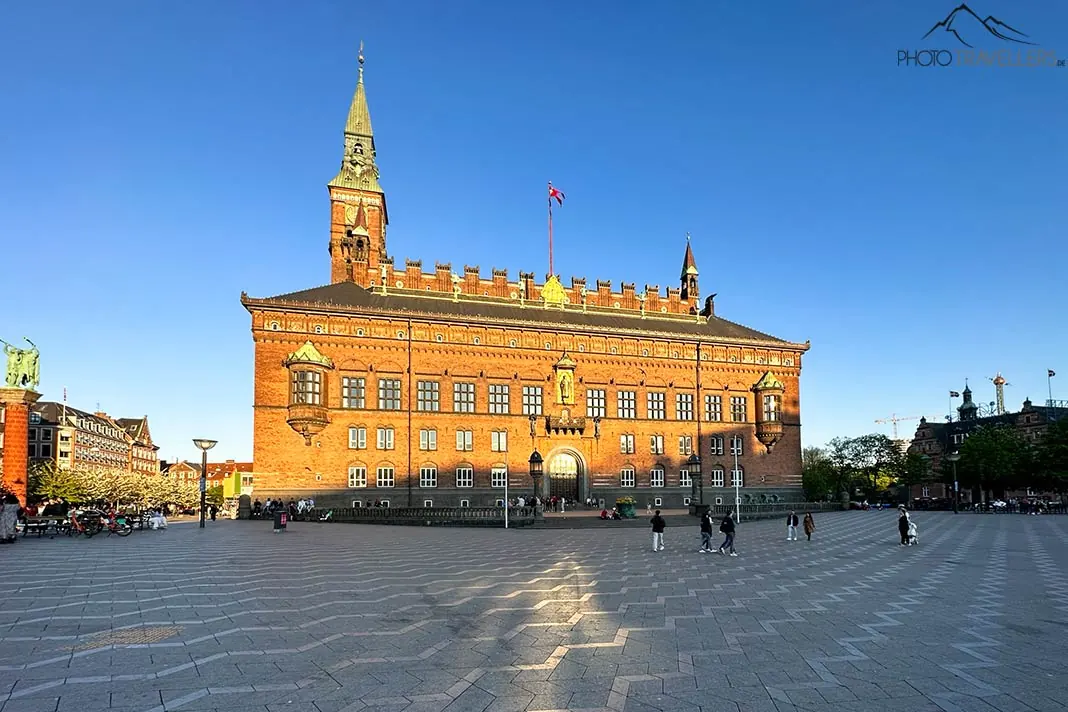
The town hall, completed in 1905, towers in the center of the old town. Take a look at the various elements of the façade, such as the huge clock on the tower and the gilded sculpture of the city’s founder, Bishop Absalon of Lund, above the main portal.
Incidentally, the famous town hall bell rang for the first time at the turn of the century and has rung every quarter of an hour from 8 a.m. to midnight ever since. It also rings in the New Year, which thousands of Danes follow with excitement on site and on television.
You can visit parts of the town hall on your own free of charge! The huge atrium is well worth a look. Be sure to take a look at the famous Verdensur – or Jens Olsen’s world clock. The astronomical clock with twelve movements is located in the vestibule of the town hall.
You can also explore the town hall as part of a guided tour (English) including a tower climb (Monday to Friday at 1 pm, Saturday at 10 am). If you just want to enjoy the view from the 105.60 meter high town hall tower (beware, 300 steps), you can do so from Monday to Friday at 11 am and 2 pm and on Saturday at 12 noon. You can buy tickets in advance here.
The building stands on the town hall square, Rådhuspladsen. This is considered a kind of “living room of Copenhagen” and is a popular meeting place. A brand new metro station, also called Rådhuspladsen, has been part of the new subway ring road since 2019 and provides better transport connections. Concerts and other events are regularly held on the Rathausplatz.
Tip: The Hotel Danmark (Vester Voldgade 89) is very close by. On the roof of the hotel is The Rooftop Bar, an open sky bar with a magnificent view. A sundowner up here is an unforgettable experience.
13. Strøget
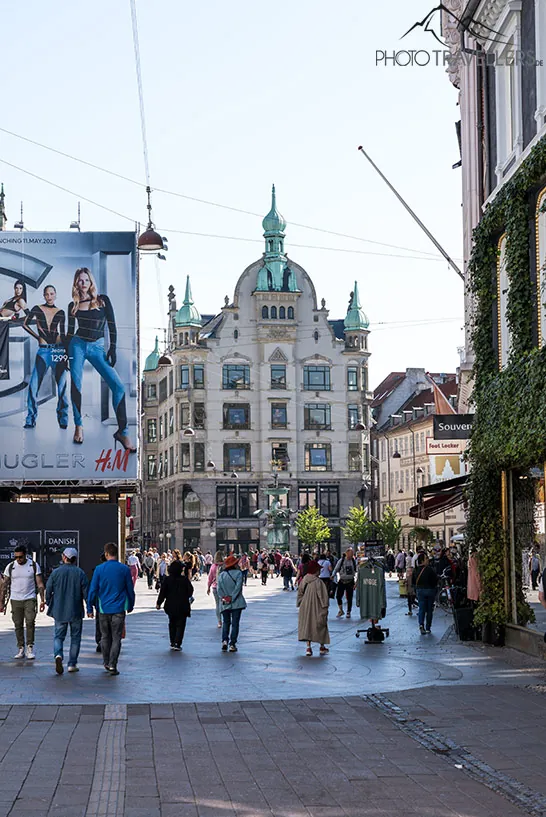
Strøget, which translates as street, leads directly from Rådhuspladsen. At over one kilometer, Strøget is one of the longest pedestrian zones in Europe.
In the famous shopping street you will find magnificent buildings, renowned stores and numerous other shopping opportunities. At the opposite end of Strøget you will find our second top attraction, the New Harbour.
We recommend a detour to the luxury department store Illums Bolighus – located on Amagertorv, the largest square in the city center – and to the side streets of Strøget. Here you will often find smaller stores and cute boutiques.
We also really liked the Gammeltorv, the Old Market, with the Caritas Fountain, the oldest fountain in the city. There are some nice cafés here.
Please note that stores in Copenhagen are only open until around 6 pm during the week and often only until 4 pm on Saturdays!
Tip: There is a cool rooftop terrace (Illum Rooftop) on the roof of the Illum shopping center – perfect for a cappuccino or an aperitif.
14. Frederik’s Church
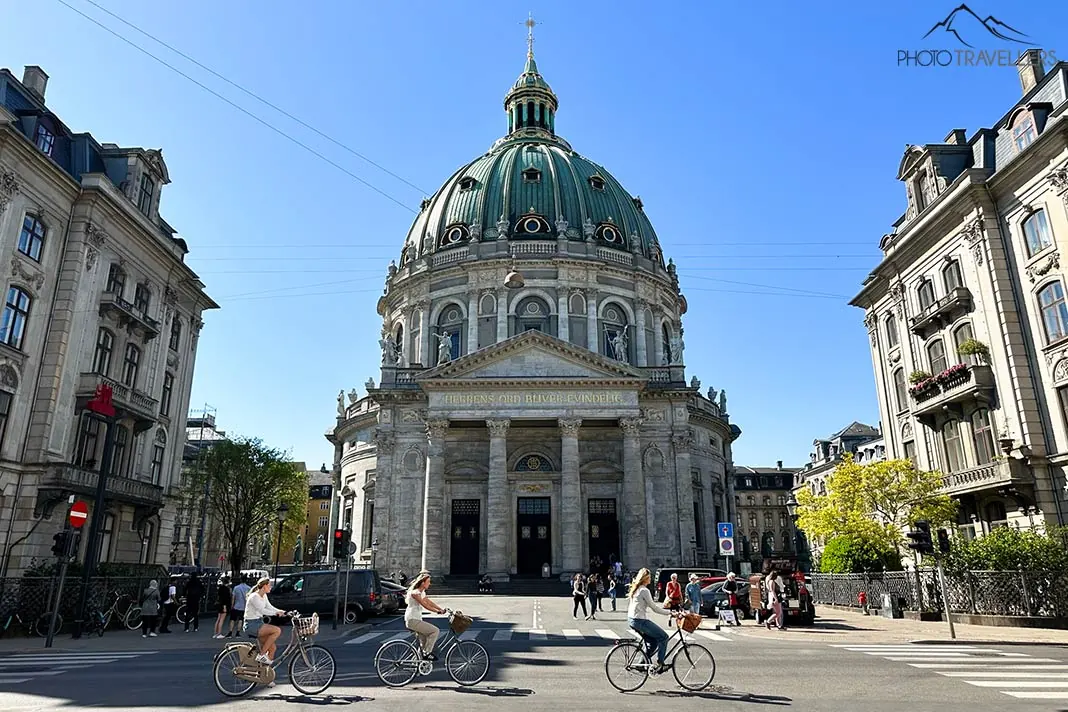 Frederik’s Church is one of the most imposing buildings in the city and is reminiscent of Rome
Frederik’s Church is one of the most imposing buildings in the city and is reminiscent of Rome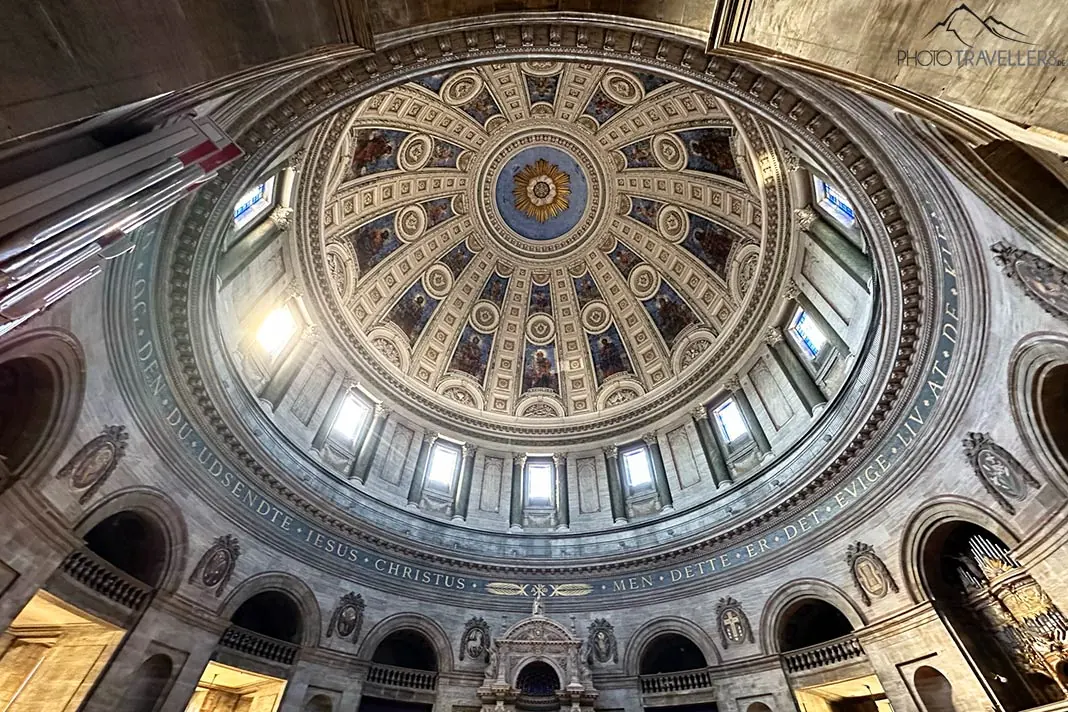 That’s just wow, isn’t it? A look inside the church is definitely a must!
That’s just wow, isn’t it? A look inside the church is definitely a must!Another exciting sight is Frederik’s Church, consecrated in 1894, within sight of Amalienborg Palace. The church, also known as the Marble Church, has the largest dome in Scandinavia and is a major feature of the city’s skyline.
Incidentally, the dome is modeled on the dome of the Pantheon in Rome. In addition, with a few exceptions, it is open at 1 pm – in summer daily and also at 3 pm, in winter only at weekends.
Admission to the church is free, only the ascent to the dome costs 50 crowns.
15. Botanisk Have with palm house
How about a green oasis instead of castles and churches? The Botanisk Have is the city’s botanical garden and is part of the university.
The first herb garden with medicinal and poisonous plants for the production of medicines was planted here around 1600. Towards the end of the 19th century, the current garden was finally created.
Now there are native, alpine and East Asian plants, among others. Over 20 greenhouses are also part of the ensemble. One of the highlights is the striking Palm House, which was built in 1872-74. A beautiful cast-iron staircase takes you to the elevated walking path that leads you under the glass roof.
The architecture of the Palm House in Copenhagen is modeled on the Crystal Palace in London. The Palm House and the Botanical Garden are part of the Natural History Museum of Denmark.
16. Nyboder
The Nyborder district is very close to the Kastellet fortress. The district, which is well worth seeing, is characterized by mustard yellow terraced houses. The area used to serve as a navy barracks.
Today, the eye-catching little houses house normal apartments. Lots of greenery grows in between. The terraced houses are definitely a great photo motif.
Incidentally, scenes from the movie “The Danish Girl” were filmed in Nyborder!
17. Food hall Torvehallerne
In Copenhagen there are now several food halls (also known as food courts or simply old-fashioned market halls). The Torvehallerne near the Botanical Gardens and Rosenborg Castle is highly recommended.
Around 60 stores have set up shop in the trendy market hall. The foodie heart beats faster here. You’ll find everything a gourmet’s heart desires, such as delicious pralines, tasty cinnamon buns, fresh sourdough bread or fragrant focaccia. There are also exotic spices, fine oils and other specialties.
Our tip: just go with the flow, stroll through the stores and always try small portions. So you can taste and snack everywhere ;-)
18. Reffen – Copenhagen Street Food
While we’re on the subject of feasting: A trip to Reffen, one of the largest street food markets in Northern Europe, is also worthwhile! In the huge area there are numerous food stalls with street food from all over the world, as well as small stores. There is also live music and other events. Street Food is open from June to the end of October. Events take place in the remaining months.
The best way to reach this foodie paradise in the somewhat remote district of Holmen from the historic old town is by bike (at the New Harbour, cross the inner harbour bridge Inderhavnsbroen and then keep left heading north).
Or you can hop on the blue and yellow Havnebus (the blue and yellow ferries), which takes you from the Old Town to Holmen. However, we have also experienced ferries that are so full that they don’t take all the passengers and you end up waiting forever for the next ship.
There are also buses (line 2A) to Holmen. There are also parking spaces.
19. Danish National Museum
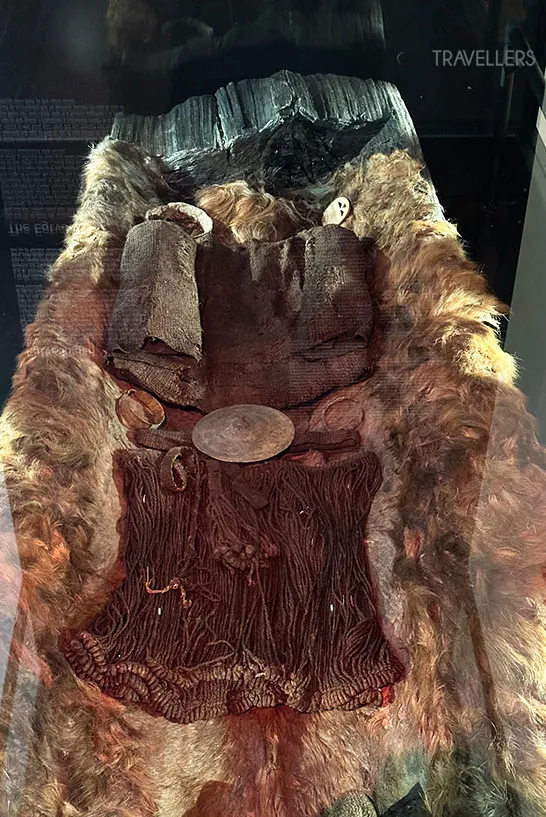 The clothes of the girl from Egtved
The clothes of the girl from Egtved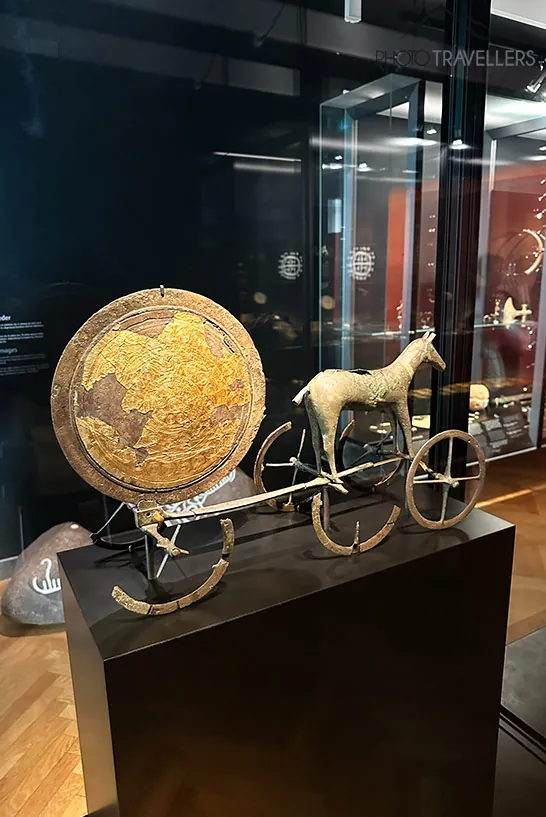 The Trundholm sun chariot
The Trundholm sun chariot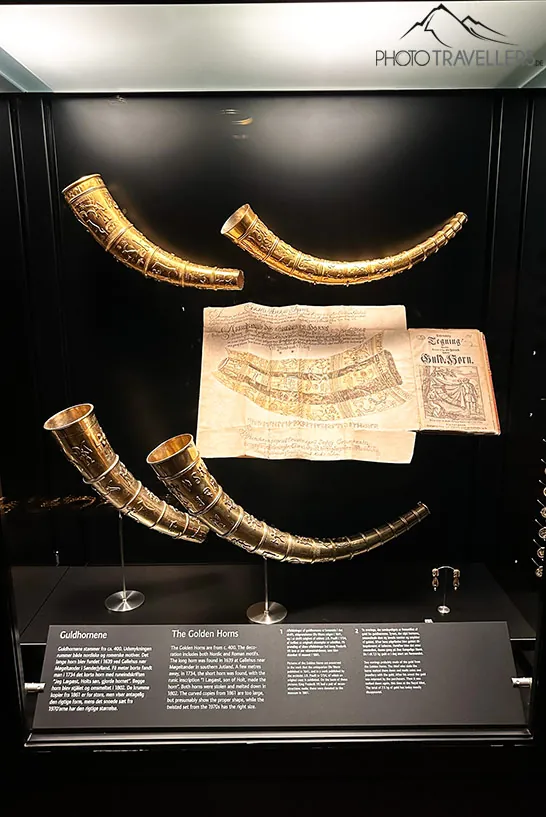 The Golden Horns of Gallehus
The Golden Horns of GallehusOne of the most famous museums in Copenhagen is the Danish National Museum. In addition to exciting individual exhibitions, you will find really great unique pieces in the National Museum.
For example, you will discover the historical clothing of the girl from Egtved, see the sun chariot from Trundholm and many unique gold treasures. There are also mummies, but also really old ship parts. Another highlight are the replicas of the Golden Horns of Gallehus, which are among the most famous archaeological finds in Denmark. Unfortunately, the originals are lost forever. In 1802, the goldsmith Niels Heidenreich stole the horns and melted them down.
We recommend that you plan plenty of time for the museum. There are so many rooms to discover where you can learn all about the history of Denmark.
Tip: The Copenhagen Museum (Københavns Museum) is very close by. Make a stop here too and treat yourself to a delicious cake and a drink at Café Spirrevippen.
20. Frauenkirche – Copenhagen Cathedral
If you are interested in the Danish royals, a visit to the Church of Our Lady (also known as Copenhagen Cathedral) is a must. Crown Prince Frederik and Mary Elizabeth Donaldson were married in the city’s main church.
Inside, the church is quite plain. The bright walls and high ceilings, decorated with gold, also radiate something regal.
21. Danish Royal Library
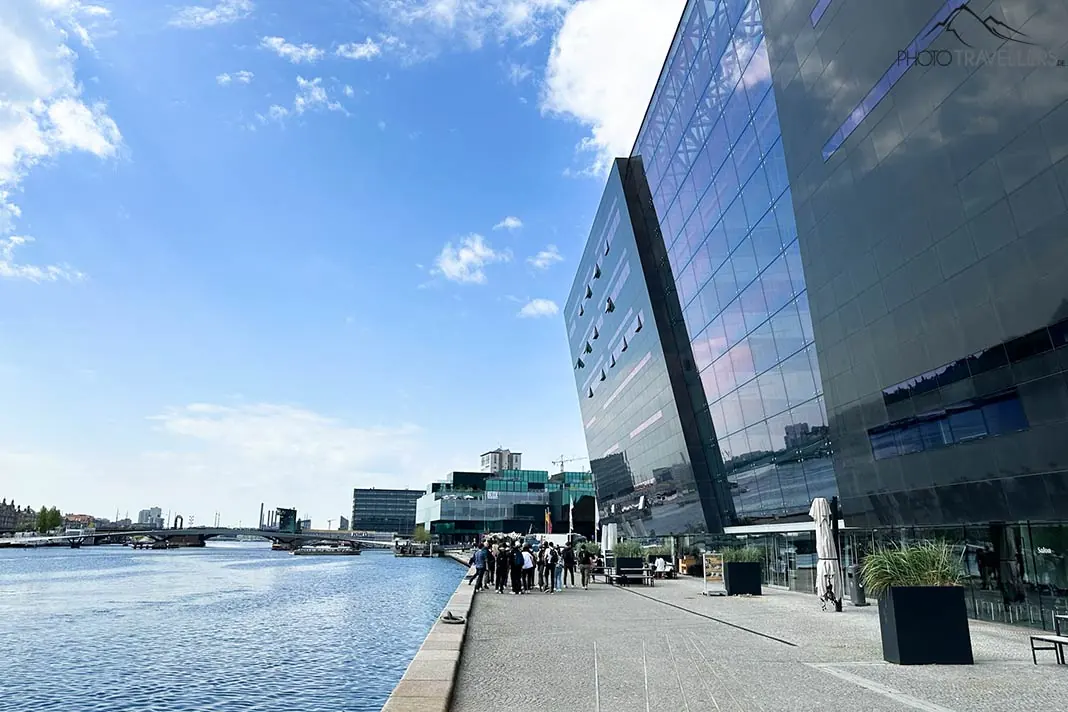 The Danish Royal Library is also known as the “Black Diamond”
The Danish Royal Library is also known as the “Black Diamond”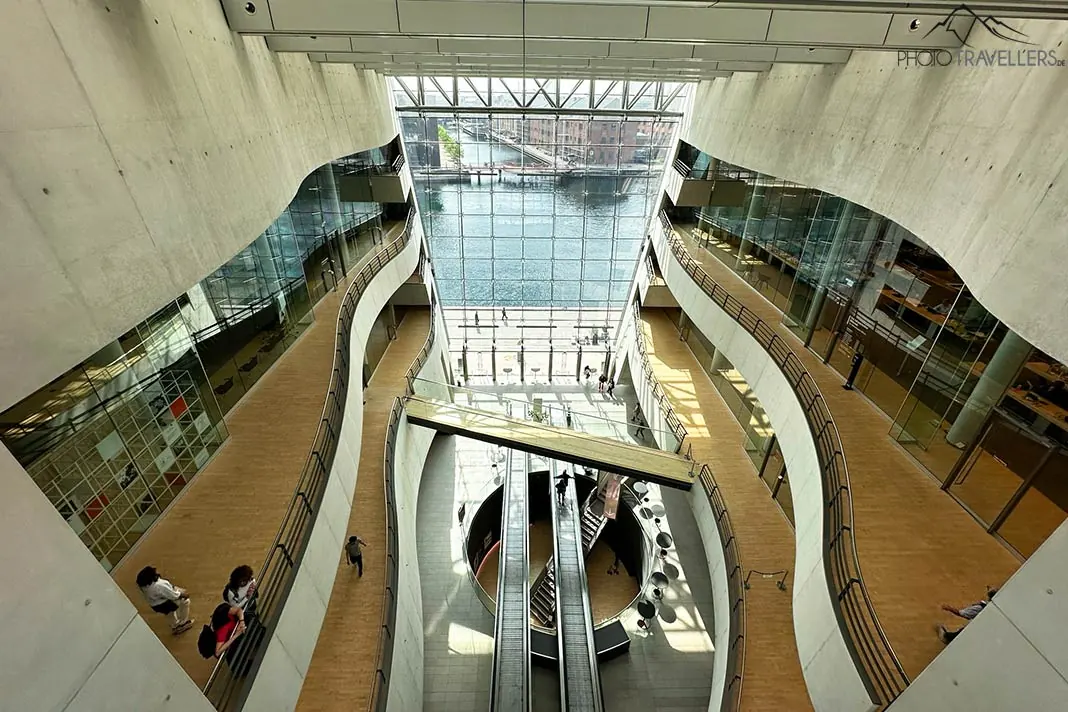 The atrium of the library is a popular photo motif. Outside you can see the Cirkelbroen pedestrian bridge
The atrium of the library is a popular photo motif. Outside you can see the Cirkelbroen pedestrian bridgeA visit to the Danish Royal Library, known as the“Black Diamond” because of its black façade, is also worthwhile. Inside the library, be sure to go to the viewing platform of the atrium, which is one of the most famous photo spots in modern Copenhagen.
The hall of the large library is also worth a visit. Visitors can look into the huge hall from outside through windows. Tourists are requested not to enter the hall (due to the noise level). There are also small exhibitions in the library (unfortunately not free of charge). It’s best to see for yourself whether the topics interest you and then decide.
There is also a café in the library with delicious drinks and food. If you like, you can sit outside on the bank in the sunshine.
Opposite the library is a really cool pedestrian bridge, the Cirkelbroen, one of the city’s newer landmarks. The flat round-trip boats can pass under the bridge. For larger ships, three of the five round platforms can be opened horizontally as a swing bridge in around 20 seconds.
If you have time, take a detour to the nearby garden of the Royal Library (Det Kongelige Biblioteks Have). In the park, you can relax by a large fountain – in the middle of the city.
22. The Kissing Stairs and Ofelia Plads
The“Kissing Stairs” are located on the waterfront between the New Harbor and Amalienborg Palace near the Copenhagen Admiral Hotel. The steps right by the water are of course not a classic sight, but they have become a popular meeting place.
In the warm summer months, you can buy a cocktail or a cold beer here (both extremely expensive, but that’s typical of Denmark) or a delicious cappuccino at one of the mobile coffee shops and sit in the sun by the water. The perfect place to end a mild summer’s day.
Ofelia Plads, a pier with bars and food trucks, is just a stone’s throw away. Concerts and other performances also take place here. Definitely a place in Copenhagen that you have to see!
This is also where the extremely popular Hey Captain boat tours start (you’ll see the black boats with the white logo on the water again and again). The tours with a maximum of twelve people on board are marketed as “social sailing” – and with great success (to the website).
23. Kartoffelrækkerne
If you’re spending more than just two or three days in Copenhagen and you’re interested in more unusual places, it’s worth making a detour to the pretty Kartoffelrækkerne district. These are eleven cute streets with quaint terraced houses arranged like potato patches. The view of the district from above is particularly impressive (but unfortunately we don’t have a picture).
The district lies between parts of the former city wall “Østre Anlæg” and Sortedams Lake (Sortedams Sø), a popular local recreation area. You can stroll through the streets here, soak up the Nordic flair and relax by the lake.
24. Superkilen in Nørrebro
Our next attraction is certainly not for everyone – and yet it should not be missing from our list. Superkilen Park in the north-west of the city is characterized by the Red Square, which got its name from the painting of the ground, walls and house facades in various shades of red, which are unfortunately quite faded today. This is followed by the Black Square, which is the heart of the park and a popular meeting place with its barbecue areas and chess boards. However, this is followed by a natural green area.
Overall, this gives the park its elongated shape and characteristic red-black-green color scheme. The Superkilen therefore follows a very special concept that you should definitely take a look at. And it goes without saying that this place is definitely Instagram-worthy! The hills of the Black Square are particularly popular for this.
The park is located in the traditional working-class district of Nørrebro, whose residents are made up of more than 60 different nationalities. For example, there are various sculptures in the park that represent the different countries, and the signage is often multilingual. It’s also super exciting to explore the multicultural district!
25. Børsen – the old stock exchange
Very close to Christiansborg Palace is the old stock exchange(Børsen), one of the oldest and most famous buildings in Copenhagen.
The pointed tower, which cannot be overlooked, represents four intertwined dragon tails and is one of the city’s landmarks. However, the building itself is not open to the public. However, the imposing building is a great photo opportunity (unfortunately, I failed to take a photo).
Excursion tip: Kronborg Castle – home of Hamlet
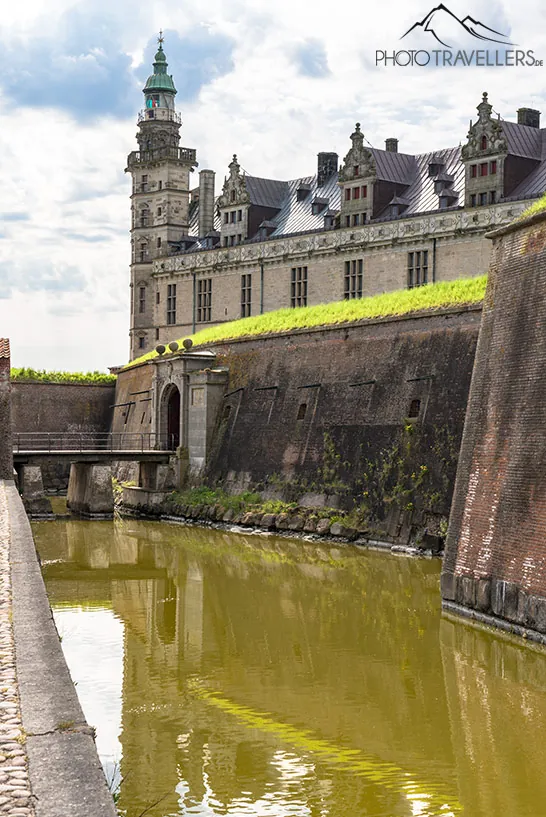 Kronborg Castle is surrounded by a moat
Kronborg Castle is surrounded by a moat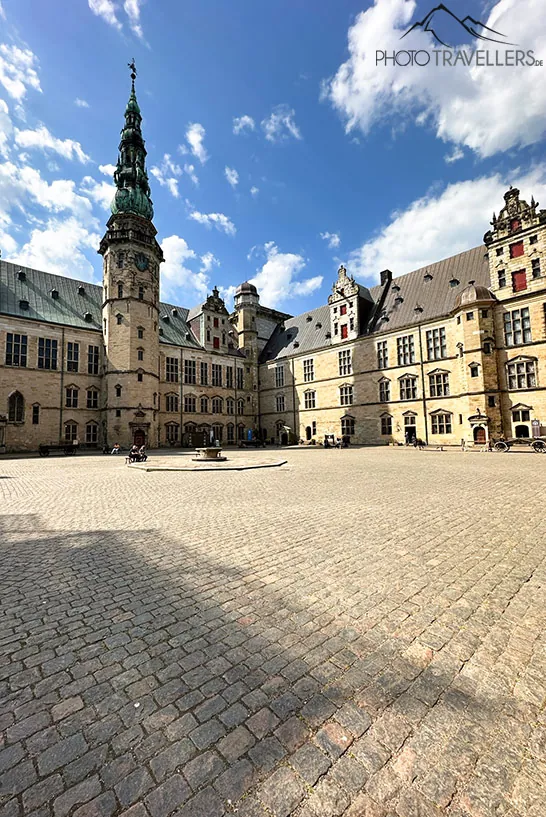 Doesn’t the courtyard look magnificent?
Doesn’t the courtyard look magnificent?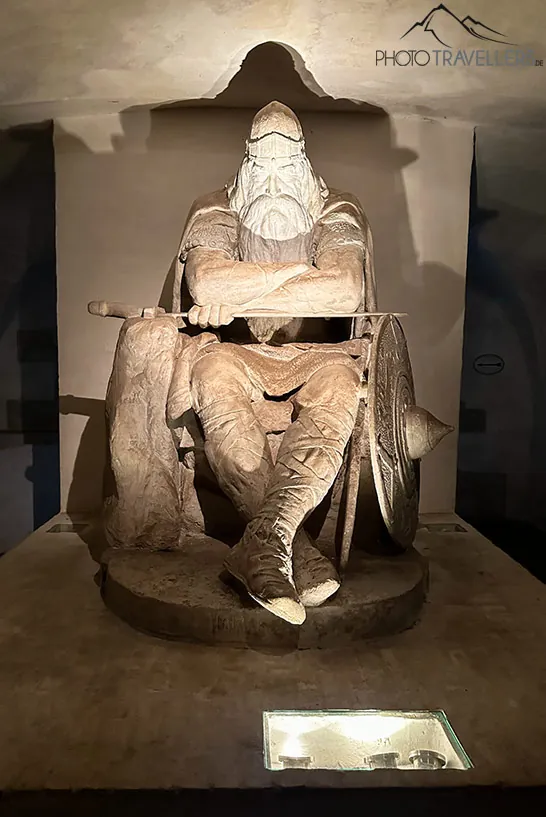 The warrior Holger Danske rests until Denmark gets into trouble
The warrior Holger Danske rests until Denmark gets into troubleA great excursion tip is the UNESCO World Heritage Site Kronborg Castle (Kronborg Slot), just 45 minutes by train from Copenhagen Central Station. The train journey to Helsingør is included with the Copenhagen City Card Discover*. The castle is one of the most beautiful Renaissance castles in Northern Europe. Kronborg Slot became famous as the setting for William Shakespeare’s drama Hamlet.
The first fortress was built here as early as 1420. It was used to collect customs duties from ships that wanted to pass through the Öresund. The fortress was later enlarged and became the royal residence. In 1629, the castle burnt down – apart from the castle church – and was rebuilt. In addition to the church, today you can visit the royal rooms, such as the great hall where King Hamlet was murdered – according to Shakespeare.
The casemates are located beneath the castle. These are vaults protected from artillery fire. The casemates are a scary and exciting adventure, especially for children. Especially as the legendary“Holger Danske“, an important national symbol for the Danes, rests down here. Can you find the statue of the grumpy warrior in the dark vaults?
By the way, the cute little town of Helsingør (where the train arrives) with its harbor is also worth a visit.
Extra tip 1: Copenhagen from above
Here we briefly summarize the best viewpoints in the city:
- The tower of Vor Frelsers Kirke (Church of the Redeemer)
- Viewing platform on the Rundetårn (Round Tower)
- The 106 meter high tower of Christiansborg Palace (free access)
- The 105.60 meter high town hall tower
- The Rooftop Bar on the roof of Hotel Danmark (Vester Voldgade 89; Google Maps)
- The 80-metre-high Himmelskibet (the world’s largest chain carousel) and the Golden Tower (a 63-metre-high freefall tower) at Tivoli amusement park
- Roof terrace of the Illum shopping center in the main shopping street Strøget
Extra tip 2: Experience Copenhagen for free
Unfortunately, a trip to Copenhagen is not cheap. A beer in a beach bar (0.3 l), for example, can easily cost 10 euros or more. Here you will find a brief overview of the Copenhagen highlights that you can visit for free:
- The Little Mermaid is free of charge and accessible around the clock
- Sit somewhere on the shore of Nyhavn in the evening and watch the hustle and bustle
- Climb the tower of Christiansborg Palace – admission is free
- Take a walk through the Kastellet, the old fortress from the 17th century
- Take a look around the free city of Christiania
- Take a look into the atrium of the imposing town hall
- Admission to the imposing Frederik’s Church is also free
- Large parts of the botanical garden are accessible free of charge
- Visit the Danish Royal Library and take a detour to the Royal Library Garden
- Go to the roof terrace of the Illum shopping center in the main shopping street Strøget
- Admission to the Davids Samling Museum near Rosenborg Castle is free
Food & drink – the best restaurants
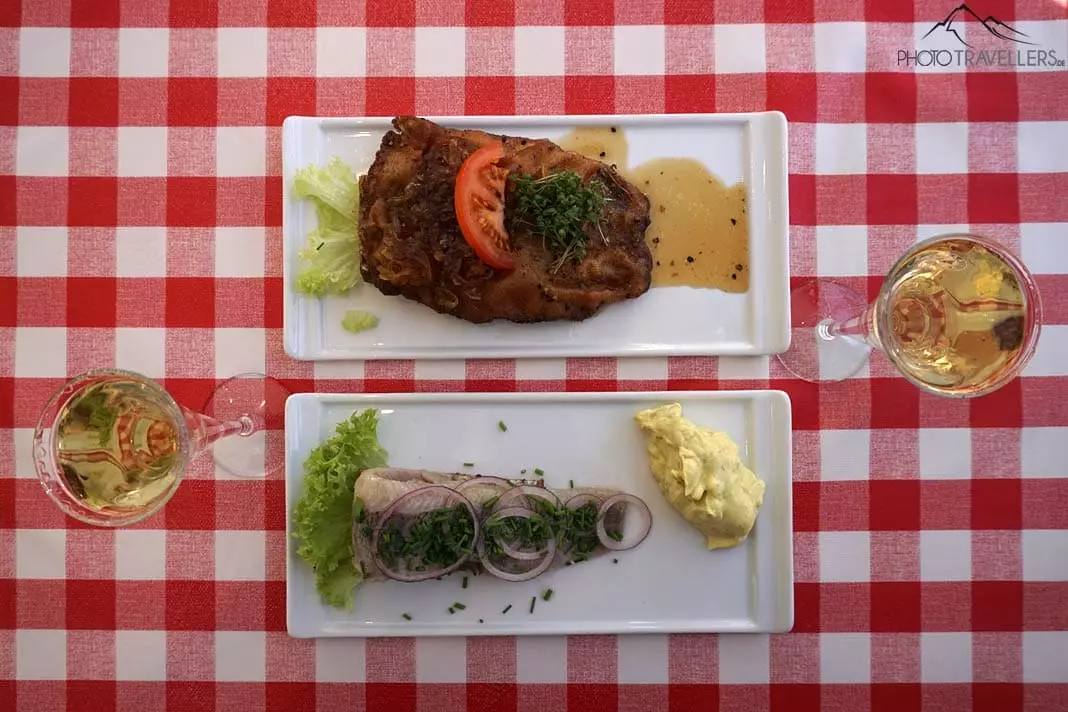
If you are in Copenhagen, you must try Smørrebrød. The Danish specialty consists of a slice of rye bread with salted butter and lush topping. Smørrebrød is therefore also eaten with a knife and fork. Perhaps You know the term from the Danish master chef from the Muppet Show, who is Swedish, by the way.
Ida Davidsen is an absolute cult restaurant that sells the breads. The restaurant (Google Maps) is over a hundred years old and was even entered into the Guinness Book of Records with its 178 smørrebrød varieties, presented on a 140-centimeter-long list.
Restaurant Vækst (Google Maps) looks like a greenhouse on the inside. In addition to a stylish interior, the restaurant offers an incredibly tasty menu (always vegetarian). We were enchanted.
One of the most popular places to go for street food is Copenhagen’s food markets. The most popular are the aforementioned Torvehallerne in Nørrebro (Google Maps) and the Reffen on the site of an old shipyard in the harbor (Google Maps). The Tivoli Food Hall right next to the Tivoli amusement park has rather poor ratings (so we didn’t test it).
And the Danes can also do drinks. Beer first and foremost. Do you remember the art collection at the Ny Carlsberg Glyptothek and who commissioned the Little Mermaid? Both are backed by the well-known Danish brewery Carlsberg.
It was founded in 1847, is the fourth largest brewery group in the world and is based in Copenhagen. You can take part in a guided tour there, for example. We can also recommend a general beer tour* in the city! Discover Danish beer culture and the trendy Vesterbro district on this tour of Copenhagen.
What to do when it rains?
The Experimentarium in Hellerup is the top tip for families, but also for adults who like to experiment. The museum is located a few kilometers (about 15 minutes) by car from Copenhagen. It is the largest science museum in Denmark and is definitely worth a visit. You can easily spend the whole day here with the kids.
In addition to the castles and museums already presented, there are many other great options. Here’s a list of the best museums, opera houses and exhibitions in Copenhagen that are perfect for a rainy day:
- Copenhagen Museum (Københavns Museum)
- ARKEN Museum of Modern Art
- Copenhagen Contemporary
- Louisiana – Art Museum
- SMK (Statuens Museum for Kunst) – the National Gallery of Denmark
- Opera, theater and ballet at the Royal Theater
- Insider tip: Exhibitions in the Danish Royal Library
Where to stay in Copenhagen: our hotel tips
There really is something for everyone when it comes to accommodation in Copenhagen. If you like luxury, the 5-star Nimb Hotel (check prices*) is the right place for you. It looks almost like an oriental palace and is located right next to the Tivoli amusement park, to which you also get free entry if you stay overnight at the hotel.
The 4-star citizenM Copenhagen Radhuspladsen hotel (check prices*), which is a little less ostentatious and much more modern, is located very close to City Hall Square. Here you will find paintings by Danish artists both inside and out, and the rooms are equipped with MoodPads that control the lighting, temperature and devices such as the TV.
Dreaming of a hotel like in Bali or Thailand? Then Manon Les Suites Guldsmeden (check prices*) is the right place for you. The pool is located in a real plant oasis. The rooftop lounge and trendy lobby also make for great photo content.
The two-star Rye115 Hotel (check prices*) is located in a quieter area, namely the cozy trendy district of Østerbro. From here, too, you only need ten minutes to get to the city center and share a bathroom and a beautiful garden with the other guests.
Map with all sights in Copenhagen
You can find all the sights and insider tips in Copenhagen on our interactive city map.
[mapsmarker map=”296″]
